Mathematical Treasures: Smithsonian National Museum of American History Object Groups
Historical mathematical objects are found in collections throughout the 19 museums and galleries that comprise the Smithsonian Institution (along with the National Zoological Park and 9 research facilities). As curators, staff, and volunteers pursue an Institution-wide goal to digitize over 138 million artifacts and specimens and over 2 million library volumes, an ever-growing number of the mathematical objects may be found in the Smithsonian's Collections Search Center.
The National Museum of American History (NMAH) has made it even easier to identify and locate similar types of objects by featuring Object Groups on its website. (For an explanation of object groups, see the article by Amy Ackerberg-Hastings and Amy Shell-Gellasch, "Online Museum Collections in the Mathematics Classroom.") Convergence's Mathematical Treasures feature at least one object from each of these groups; the page for each object includes a link to the complete object group at NMAH.
These images may be used for instructional and educational purposes; for all other uses, please obtain permission from NMAH's Archives Center.
Mathematical Treasures from NMAH Object Groups
- Abaci & Numeral Frames – Modern Chinese Abacus
- Adders – Troncet Arithmographe Owned by Daniel Draper
- Adding Machines – Jean Lepine’s Stylus-Operated Adding Machine
- Adding Machines – Thomas Hill's Patent Model for a Key-Driven Adding Machine
- Arithmetic Teaching Apparatus – Add-A-Count Scale for Teaching Arithmetic
- Bookkeeping Machines – National Class 3000 Bookkeeping Machine
- Calculating Machines – Frederick A. P. Barnard's Calculating Machine
- Cash & Credit Registers – Model Cash Register Designed by the Ritty Brothers
- Charter Members of MAA – Geometric Model by Harry Wheeler, 1915
- Counters – Moffett Register for Recording Alcohol Sales
- Dividers & Drawing Compasses – Maurice Kidjel's Ratio Cali-Pro
- Electronic Calculators (Desktop) – Wang Loci-2 Programmable Calculator
- Electronic Calculators (Handheld) – Hewlett-Packard HP28S from the AMS Centennial Meeting
- Ellipsographs – Keuffel & Esser Trammel Ellipsograph
- Flowcharting Templates – RCA Flowcharting Template
- Geometric Models – Dissected Rhombic Dodecahedron by A. Harry Wheeler
- Geometric Models – Elongated Pentagonal Pyramid
- Geometric Models – Jullien Models for Descriptive Geometry
- Geometric Models – Paper Model of Elliptic Paraboloid by Brill
- Geometric Models – Thermodynamic Surface by Richard P. Baker
- Geometric Models – Transformable Plane Dissections by A. Harry Wheeler
- Geometric Models – Wire Frame for Soap Film Minimal Surface by Brill
- Kinematic Models – Hypotrochoid Kinematic Model by M. Schilling
- Mathematical Charts & Tables – Number Line Owned by Andrew Gleason
- Mathematical Paintings – Crockett Johnson's Mathematical Paintings
- Mechanical Integrators and Differential Analyzers – Product Integraph by Vannevar Bush and Colleagues
- Metric System Demonstration Apparatus – Demonstration Metric Grain Measures
- Parallel Rules – Captain Field's Improved Parallel Rule
- Pens & Pencils – Rubik's Cube Museum Promotional Pen
- Planimeters – Polar Planimeter Invented by Jacob Amsler
- Protractors – Japanese Protractor for the 1876 World's Fair
- Punch Cards – Factor Stencil Punch Cards
- Scale Rules – Nels Ockerlund's Patent Model for a Combination Ruler
- Sectors – Sector from Jesse Ramsden's Workshop
- Sets of Drawing Instruments – Early Modern Drawing Instruments
- Slide Rules – Raymond Clare Archibald's Slide Rule
- Spherometers – Grunow Spherometer
- Tabulating Equipment – Statistical Tabulator of Benjamin Wood
- Teaching Machines & Mechanical Learning – B. F. Skinner’s Arithmetic Teaching Machine
- Triangles & Squares – Blackboard-Sized Triangles
- Trigonometry in the Plane – Trigonometer for Use with World War II Artillery
- Trigonometry on the Sphere – Model of Spherical Triangle by A. Harry Wheeler
- Women in Mathematics – Objects Related to Women Mathematicians
- Women Teaching & Learning Mathematics in the United States – Boole Senior Blocks Designed by Edith Dummer Mintzer
Mathematical Treasure: A Number Line Owned by Andrew Gleason

Number Line, about 1972, Smithsonian Institution negative number JN2012-0821.
Mathematicians, mathematics educators, engineers, students and diverse other numerate people long relied on printed charts and tables. These not only conveniently listed numerical information, but sometimes illustrated mathematical ideas.
From the time of Descartes (1596–1650), mathematicians have described positive and negative integers as evenly-spaced points on a line, now called the number line, extending infinitely in both directions. This usage had made it into some school textbooks by the early 20th century. Particularly at the time of the development of the New Math in the 1950s and 1960s, number lines became part of the school classroom. This chart showing a number line was developed by Loraine McMillan and sold by Houghton Mifflin Company to accompany the 1972 edition of the textbook Modern School Mathematics. McMillan also published a leaflet that described the use of the object.
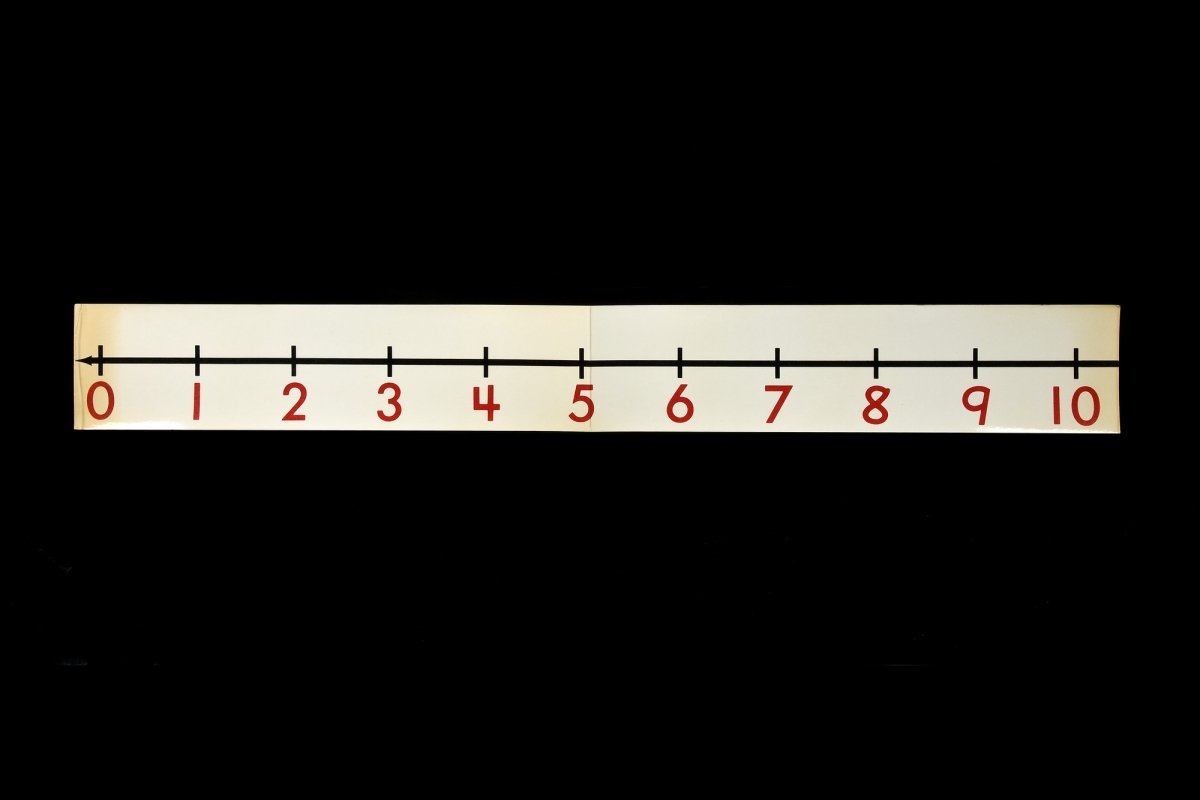
The number line was made of eleven plastic-coated cards, with the first ten numbered from 0 to 100 (the eleventh card was blank). The first of the cards is shown.
This example of McMillan’s number line was owned by Andrew Gleason (1921–2008), a professor of mathematics at Harvard University who took considerable interest in school mathematics teaching.
To find more information about mathematical charts and tables in the collections of the Smithsonian’s National Museum of American History, see the website http://americanhistory.si.edu/collections/object-groups/mathematical-charts-and-tables. For examples of books of tables, consult the catalog of Smithsonian Institution Libraries.
Mathematical Treasure: Add-A-Count Scale for Teaching Arithmetic
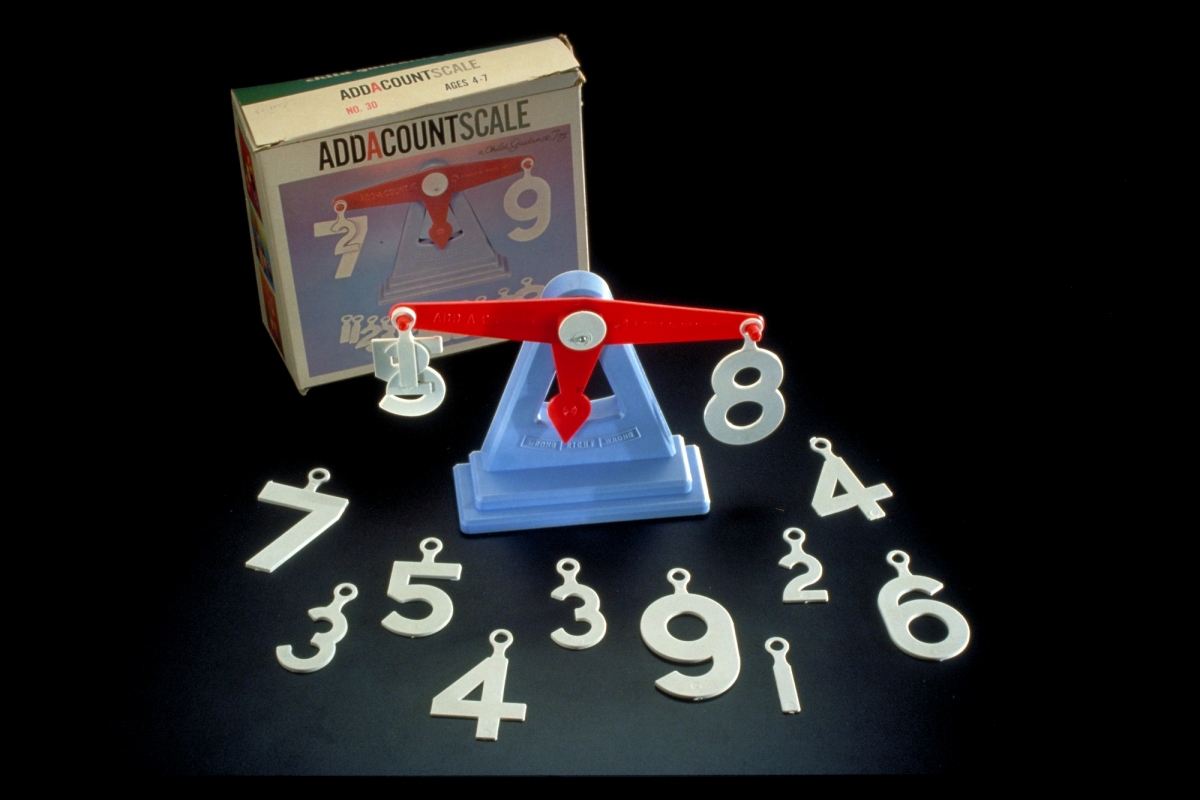
Add-A-Count Scale, 1950s, Smithsonian negative number 96-4205-4.
From the early years of the Republic, Americans used objects in arithmetic teaching. New objects tended to come to market when school populations increased substantially, as with the founding of common schools in the 1820s and 1830s and the growth of high schools in the 1890s. During the 1950s, the number of children in the United States grew rapidly. Several manufacturers introduced toys intended to communicate elementary ideas. This Add-A-Count scale, made by Child Guidance Toys of New York City, well illustrates this trend.
The red, white, and blue plastic toy is a balance with weights in the form of numbers. The weight of the weight is proportional to the value of the number. Hence a "3" on one arm will balance a "2" and a "1" on the other. There are two weights for each digit from 1 to 5 and one weight for each digit from 6 to 9, making a total of 14 weights. The weights and scale fit in a paper box, which has on it a drawing of a girl playing with the toy. In the 1960s, the toy was sold by instrument dealers such as Edmund Scientific Company of Barrington, New Jersey. It sold for $1.00—by 1968 the price was $1.50.
A wide range of objects associated with arithmetic teaching that are found in the collections of the Smithsonian Institution are described and shown on the website http://americanhistory.si.edu/collections/object-groups/arithmetic-teaching-apparatus. Textbooks and related printed materials are listed in the catalog of the Smithsonian Institution Libraries.
Mathematical Treasure: B. F. Skinner’s Arithmetic Teaching Machine
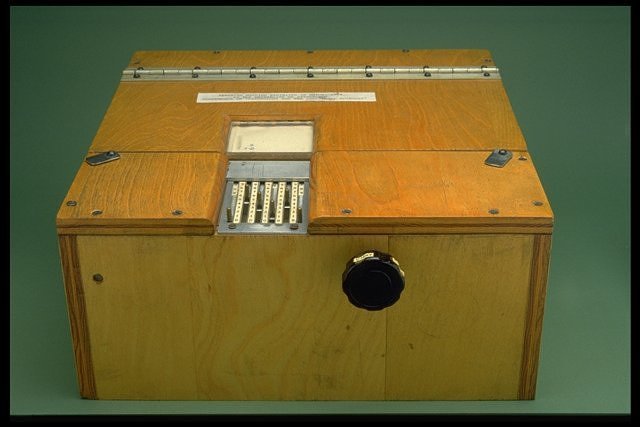
B.F. Skinner Teaching Machine, 1954, Smithsonian Institution negative number NMAH-82-6211
In the years following World War II, American school enrollments boomed. One parent, the behavioral psychologist and Harvard University faculty member B. F. Skinner, noted that students might benefit from machines that gave extra opportunities for drill. Skinner, who had first designed machines to teach laboratory animals, designed this instrument to teach children elementary arithmetic.
The hinged lid extending over the top covers a punched paper tape. A window in the lid reveals one problem at a time. In front of the window is a set of six levers that allows the user to input a number, giving the answer to the question. The machine was exhibited at a conference on psychology and the behavioral sciences held in March 1954 at the University of Pittsburgh.
A range of machines proposed to encourage learning—not always of mathematics—are described in a National Museum of American History web object group with address https://americanhistory.si.edu/collections/object-groups/teaching-machines.
Mathematical Treasure: Blackboard-Sized Triangles
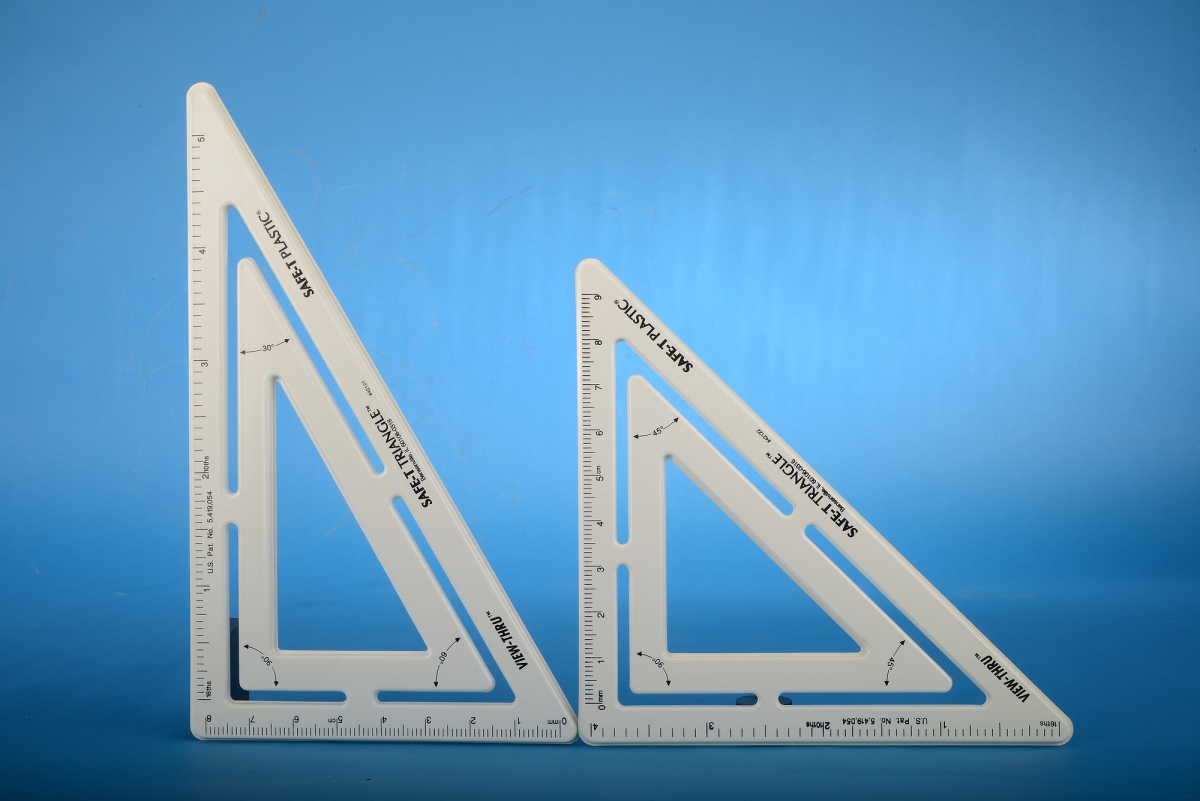
Two Safe-T Blackboard Triangles, Model Number 42123, 2000, Smithsonian Institution negative number DOR2012-8017.
In the 20th century, instrument makers began to provide mathematical calculating and drawing instruments in over-sized versions so that teachers and professors could use them at the blackboard. By the end of the century, some manufacturers had become concerned that traditional materials, such as wood or metal, could injure young school pupils. They turned to plastic because it was durable but also because it was soft and could be molded into shapes with rounded edges and corners.
This object and other set squares, T-squares, and drawing triangles from the Smithsonian's National Museum of American History are now shown and described at the website http://americanhistory.si.edu/collections/object-groups/squares-triangles.
Mathematical Treasure: Boole Senior Blocks
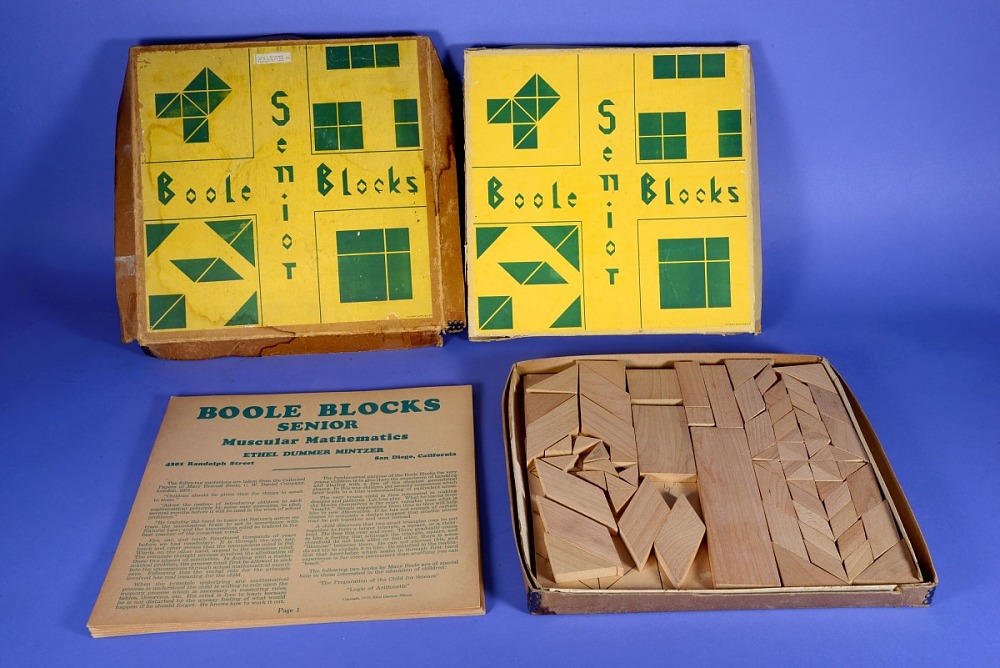
Apparatus for Teaching Young Children Mathematics, circa 1935, Smithsonian Institution negative number NMAH-AHB2016q012847
From at least the 19th century, educators have thought that playing with specially designed blocks would give children a tangible sense of mathematical relationships. The San Diego, California, teacher Ethel Dummer Mintzer (1895–1938) designed this set of flat wooden pieces to provide the experience of handling simple geometric shapes. A complete set would include one hundred forty-four blocks: right isosceles triangles in five sizes, squares in three sizes, rectangles in six sizes, and parallelograms in three sizes. Several blocks are missing from this set. The blocks are arranged in two layers on specially printed square sheets of paper and stored in a box with two bases and two lids.
Paper sheets describe possible uses of the blocks. Ideas include making patterns from given sets of blocks, representing equal fractions, rearranging blocks to form figures of equal area, and defining areas. Other sheets concern the Pythagorean Theorem, a binomial expansion, and multiplying fractions. Mintzer copyrighted the set in 1933.
The blocks are named for Mary Everest Boole (1832–1916), a British educator also known as the wife of the logician George Boole and the mother of the geometer Alicia Boole Stott. This particular example was owned by Carol B. McCamman, who taught mathematics at Coolidge High School in Washington, DC. The donor, Florence Fasanelli, taught mathematics at Sidwell Friends School in Washington. McCamman gave Fasanelli the Boole blocks in 1974 as a baby present for her daughter Antonia.
This is one of a group of objects in the collections of the National Museum of American History that were used by girls and women in mathematics education. The group may be viewed at https://americanhistory.si.edu/collections/object-groups/womenteachingandlearningmathematicsintheunitedstates.
Mathematical Treasure: Captain Field's Improved Parallel Rule
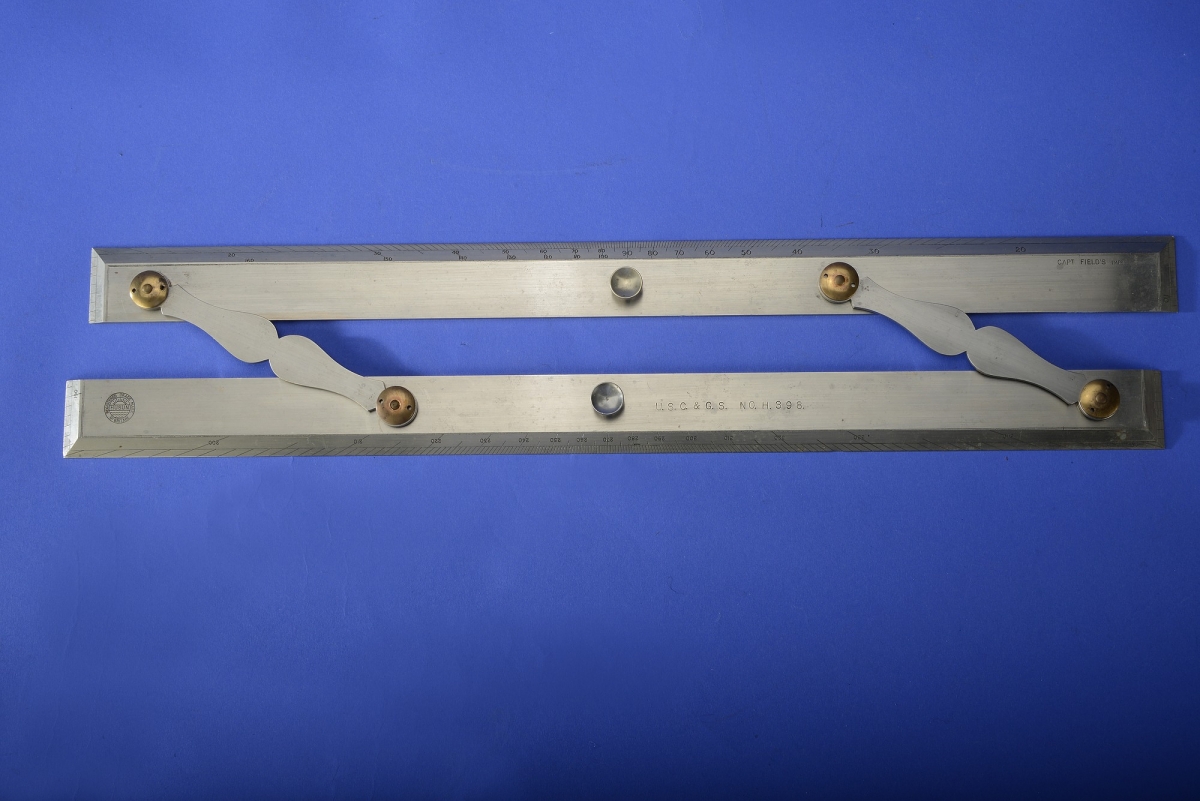
Captain Field's Improved Hinged Parallel Rule, Signed by Henry Hughes & Son, 1923, Smithsonian Institution negative number DOR2012-8041.
Parallel rules are drawing instruments used to make accurate parallel lines on maps, charts, and architectural drawings. In 1854, English captain William Andrew Field (or Feild, ca 1796–1871) modified the hinged form of parallel rules, which had been used in Europe since about 1600, by adding scales for 0° to 180°, like those on a protractor, and compass points. These innovations made it easier for ship navigators to move the rule without losing track of the ship's course.
Henry Hughes & Son of London manufactured metal forms of the rules, several of which were purchased by the U.S. Coast & Geodetic Survey in the early 20th century.
This object and other parallel rulers from the Smithsonian's National Museum of American History are now shown and described at the website http://americanhistory.si.edu/collections/object-groups/parallel-rules.
Mathematical Treasure: Crockett Johnson's Mathematical Paintings
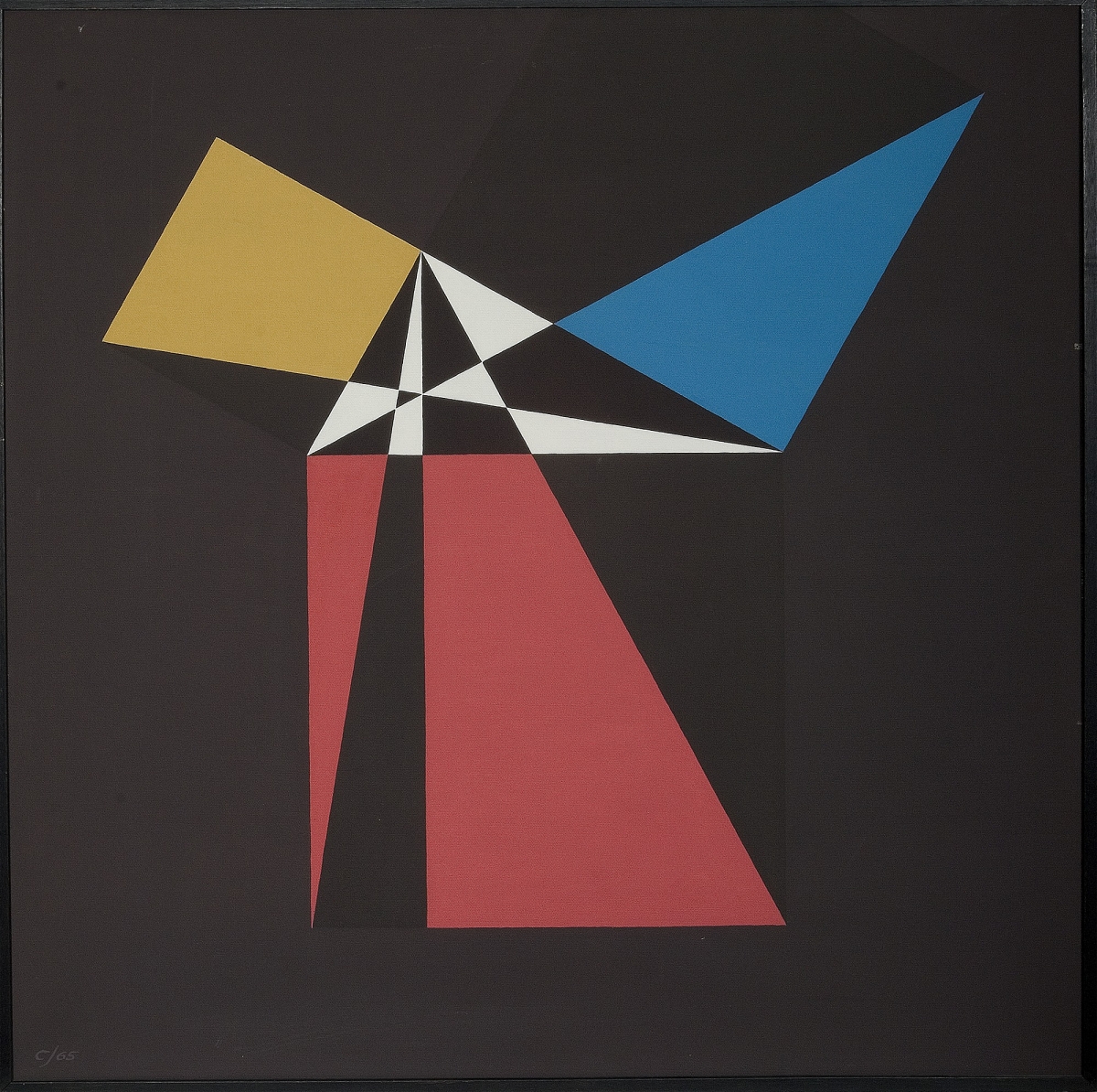
Crockett Johnson, Proof of the Pythagorean Theorem (Euclid), 1965, Smithsonian Institution negative number 2008-2519.
Although Crockett Johnson (1906–1975) is best known as the author of the 1955 children’s book Harold and the Purple Crayon and had no formal training in mathematics, from the mid-1960s he produced what he called “a series of romantic tributes to the great geometric mathematicians from Pythagoras on up” (Reinhardt Papers, Crockett Johnson Correspondence). At first he relied on diagrams from James Newman’s The World of Mathematics as well as other mathematics books, but after a few years he began creating some paintings based on original constructions.
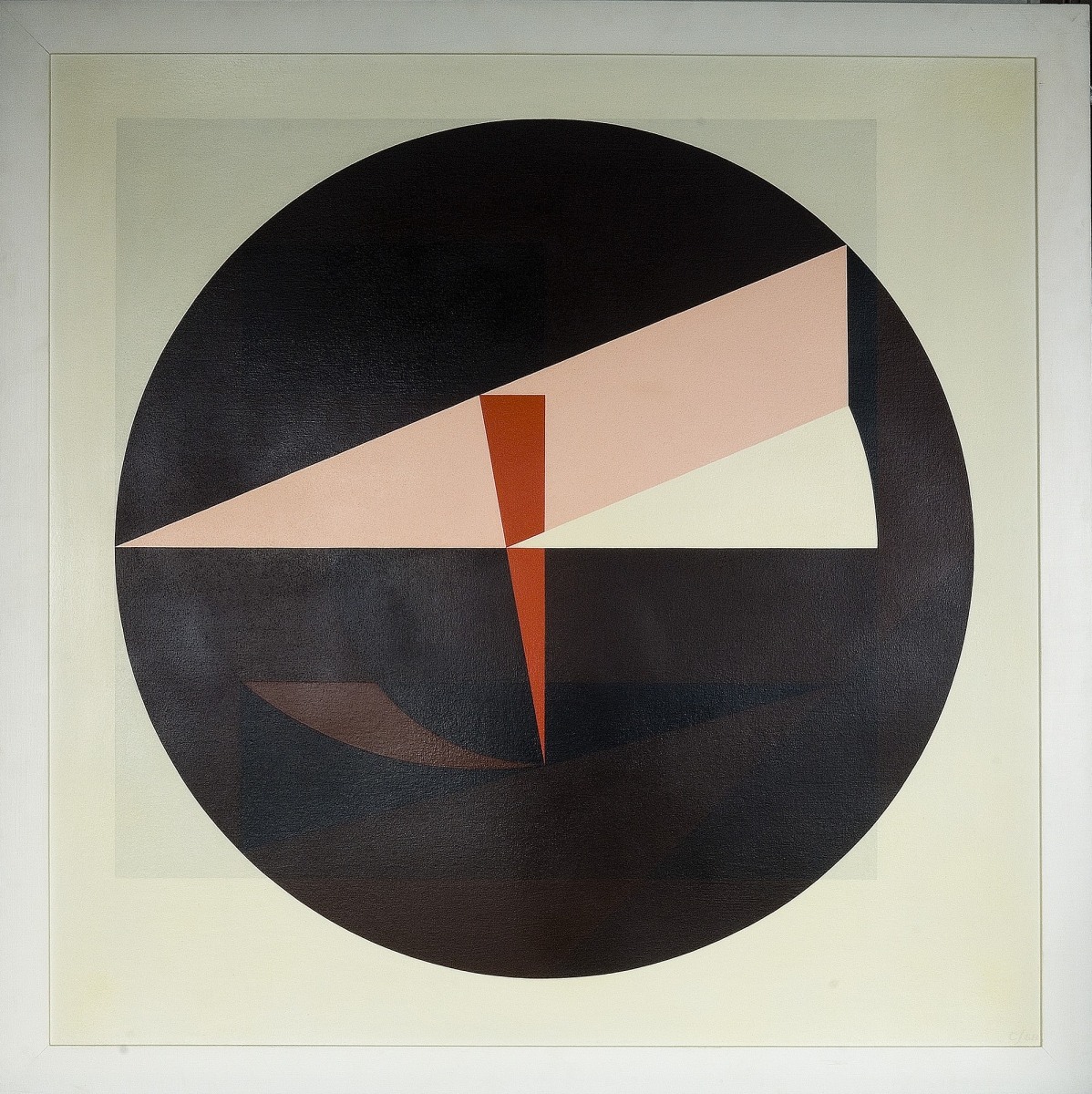
Crockett Johnson, Squared Circle, 1968, Smithsonian Institution negative number 2008-2466. This was one of Johnson's own constructions.
Eighty of Crockett Johnson’s paintings are now in the collections of the Smithsonian Institution’s National Museum of American History. They are shown and described at the website http://americanhistory.si.edu/collections/object-groups/mathematical-paintings-of-crockett-johnson.
Reference
Ad Reinhardt Papers, 1927–1968. Archives of American Art, Smithsonian Institution. Washington, DC. http://www.aaa.si.edu/collections/ad-reinhardt-papers-5659.
Mathematical Treasure: Demonstration Metric Grain Measures
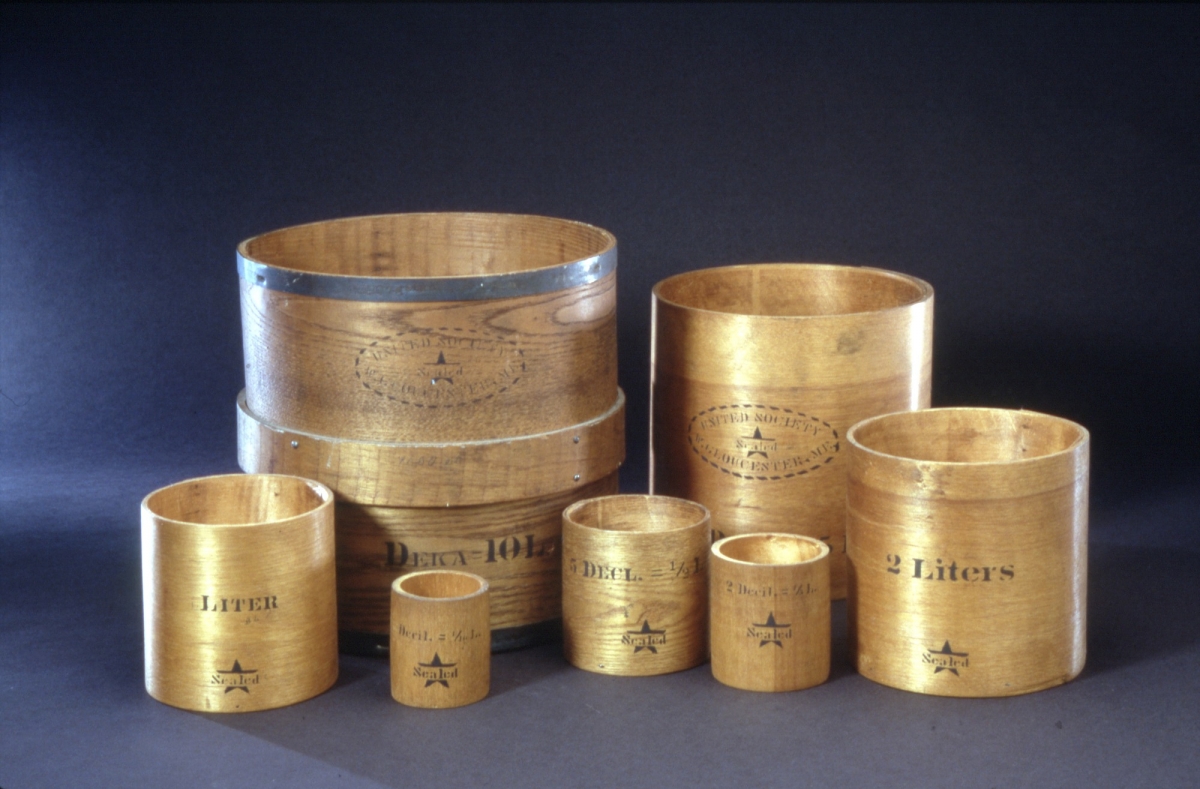
Volume Measures Made by the Shakers, 1877-1900, Smithsonian Institution negative number 92-14244.
The metric system of weights and measures developed in France in the wake of the revolution of 1789. During the early years of the American Republic, the United States also adopted national standards, but these were based on British units. Meanwhile, the metric system was widely adopted in Europe. In 1866, the United States government approved legislation making the metric system legal but not mandatory in the United States. New metric standards were prepared for the states.
To teach the system, an organization known as the American Metric Bureau encouraged production of special apparatus. This set of grain measures was made by members of the United Society of Believers, or Shakers, a group known for its skilled woodworkers. From March of 1877 until at least 1900 the Shakers of West Gloucester (later Sabbathday), Maine, sold demonstration metric measures like these.
The metric system was widely adopted by scientists and doctors in their work. However, some Americans strongly opposed metric units and many were content to use familiar measures, so metric units did not become common throughout American society.
For further information about and images of objects relating to the history of the metric system in the United States, see the website for metric system demonstration apparatus at the National Museum of American History, http://americanhistory.si.edu/collections/object-groups/metric-system-demonstration-apparatus.
Mathematical Treasure: Early Modern Drawing Instruments
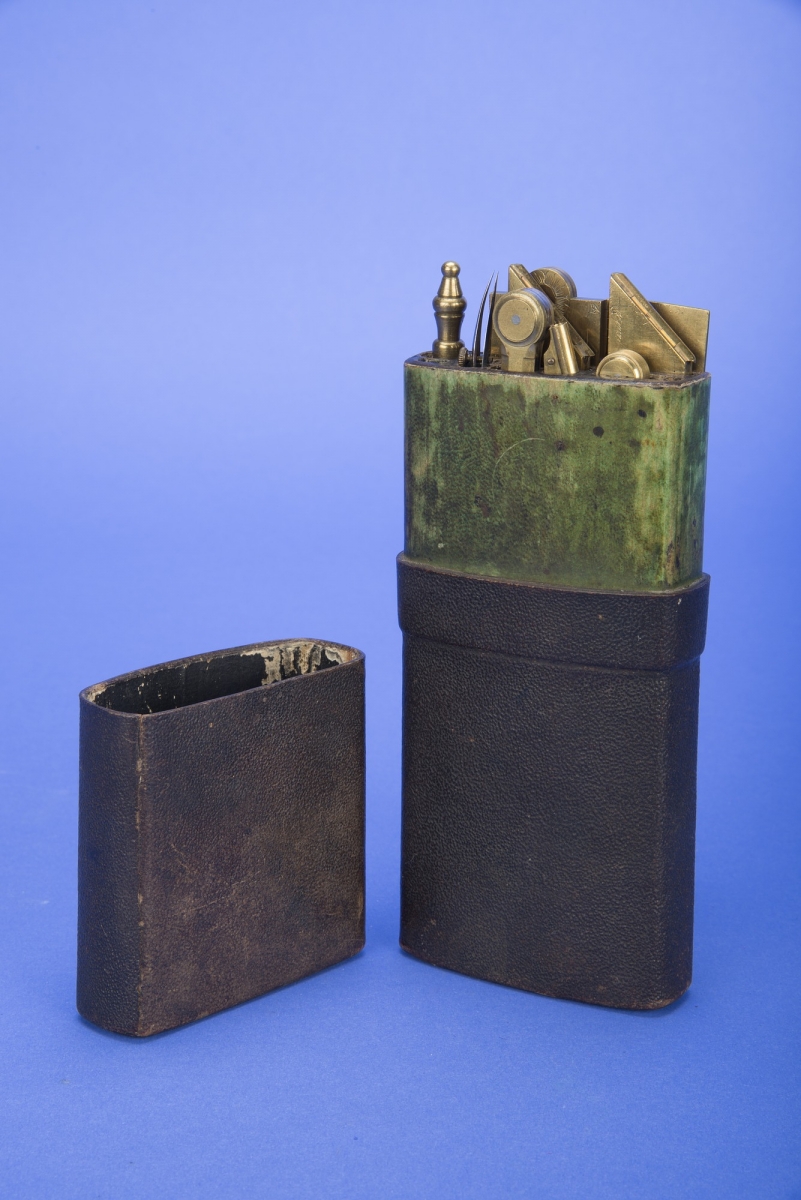
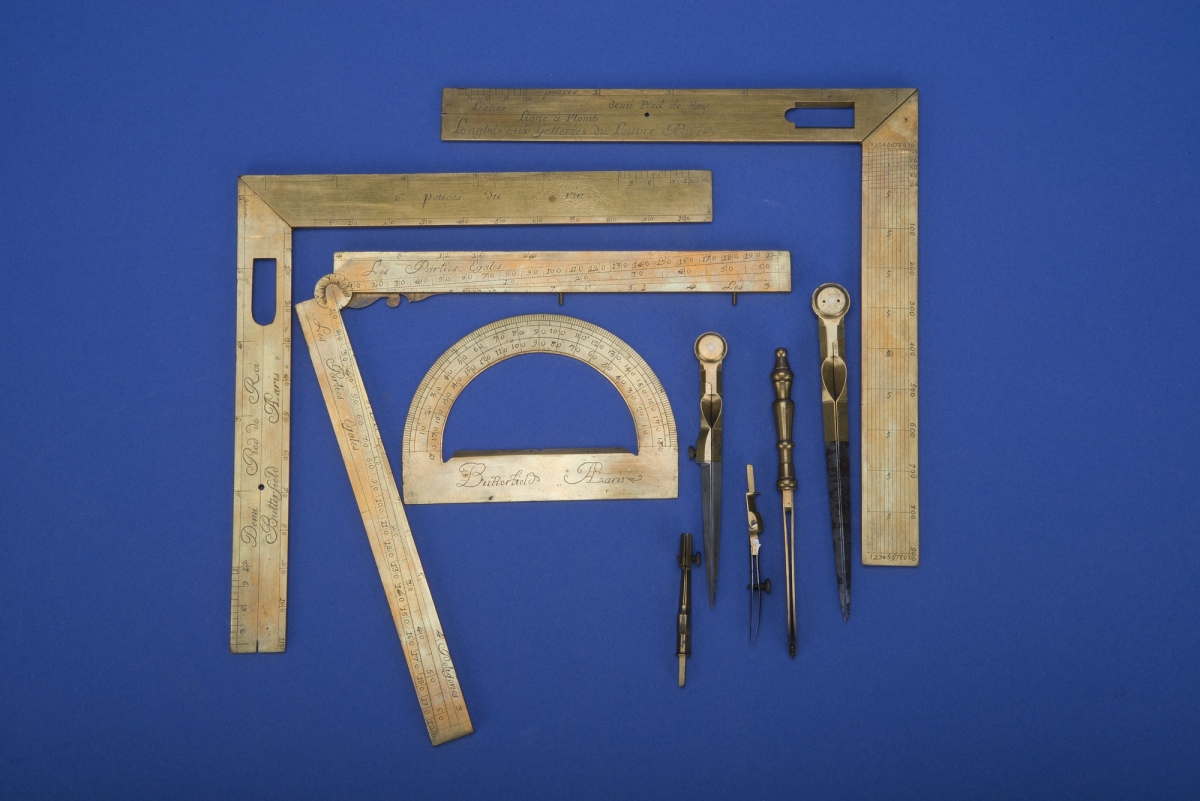
Pocket Case of Drawing Instruments, mid-18th century, Smithsonian Institution negative numbers DOR2013-17245 and DOR2013-17249.
Draftsmen, architects, surveyors, navigators, engineers, and others who apply mathematics in their daily work have historically needed to keep a variety of drawing instruments on hand. Some purchased tools at different times from different makers and either built or purchased a case in which to keep them; some purchased ready-made sets from a single instrument maker; and some purchased sets but later replaced broken or lost instruments by purchasing them from other makers.
The 18th-century instruments pictured here are stored in a wooden case covered in black fishskin that fits in a pocket. The protractor, one of the set squares, and sector all came from the shop of Michael Butterfield, which produced some of the finest craftsmanship in Paris in the late 17th and early 18th centuries. The other set square was made by the firm of Claude Langlois, which was active in Paris in the middle of the 18th century.
This case and other sets of drawing instruments from the Smithsonian's National Museum of American History are now shown and described at the website http://americanhistory.si.edu/collections/object-groups/drawing-instruments.
Mathematical Treasure: Factor Stencil Punch Cards

IBM Punched Cards used as Factor Stencils, 1939, Smithsonian Institution negative number NMAH-AHB2017q016024
From the 1890s into the 1980s, rectangular paper punched cards were the most common way to enter data and programs onto processors like tabulating machines and then computers. In the late 1920s, number theorist Derek N. Lehmer of the University of California at Berkeley developed a set of punched paper sheets to assist in factoring large numbers. John D. Elder, an instructor at the University of Michigan, realized that factor stencils also could be put on punched cards, and he produced this set in 1939. The following year, Raphael M. Robinson of the University of California at Berkeley published a set of punched cards for finding quadratic congruences—these were in a form suited for distribution to libraries.
In general, some mathematicians embraced the electronic computer, writing programs for it that were entered on punched cards. Some such cards also survive in Smithsonian collections. For a listing of the punch cards in the mathematics and computer collections at the National Museum of American History, see the web object group https://americanhistory.si.edu/collections/object-groups/punch-cards.
Mathematical Treasure: Frederick A. P. Barnard's Calculating Machine
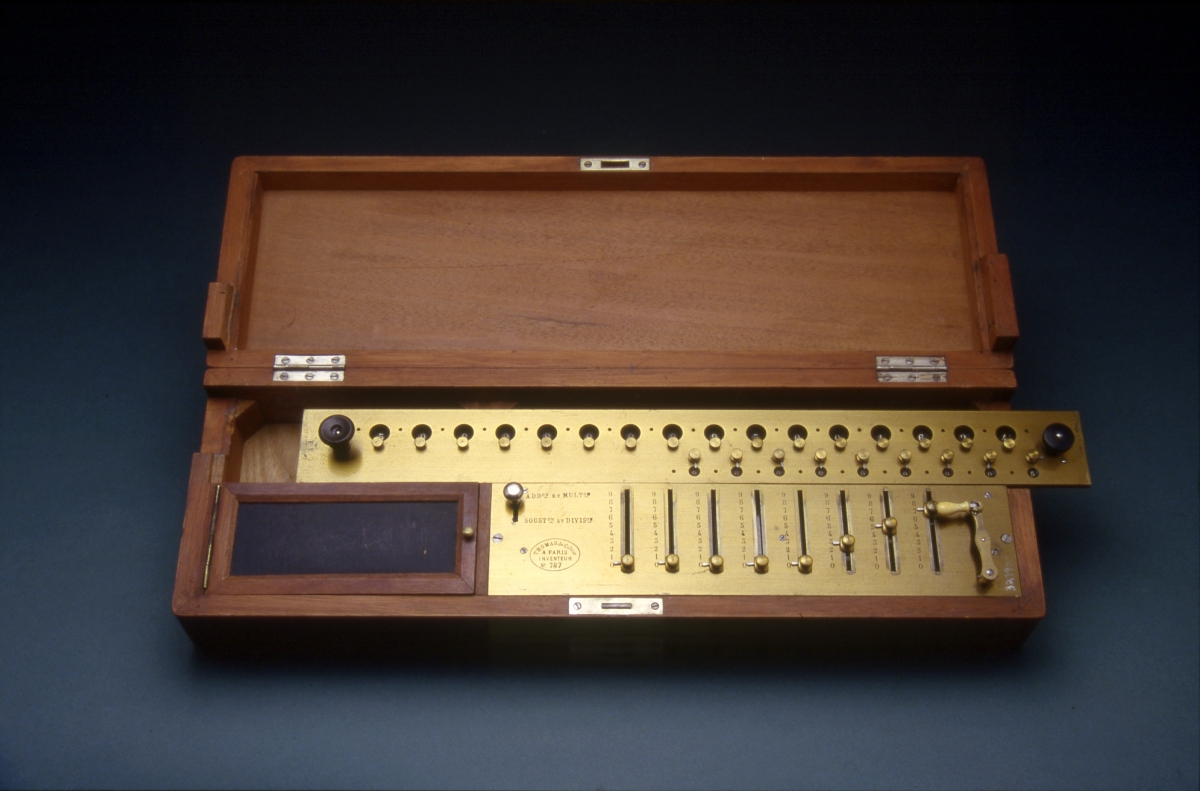
Thomas Arithmometer, 1867, Smithsonian Institution negative number 87-6436.
The mathematician, natural philosopher and Columbia University president Frederick A. P. Barnard is perhaps best remembered for encouraging advanced education in New York City, inspiring the name of Barnard College. He also took an active interest in scientific and mathematical apparatus.
Barnard served as a judge at the Exposition universelle, the world’s fair held in Paris in 1867. There he saw arithmometers made on the design of the French insurance executive Charles Xavier Thomas. Thomas arithmometers were the first commercially successful calculating machines. Barnard arranged to have this one purchased for his office at Columbia.
These and other calculating machines from the Smithsonian Institution’s National Museum of American History are now shown and described at the website http://americanhistory.si.edu/collections/object-groups/calculating-machines.
Mathematical Treasure: Geometric Model by Harry Wheeler
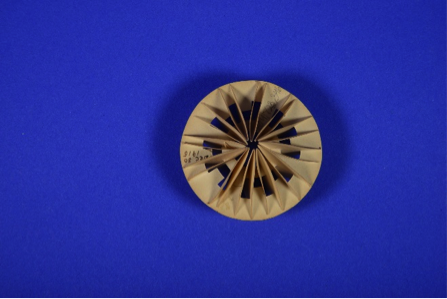
Geometric Model by A. Harry Wheeler, 1915, Smithsonian Institution image AHB2015q061380
A. Harry Wheeler, a schoolteacher in Worcester, Massachusetts, made this small paper model of a sector of a sphere on December 30, 1915. At that time, now a century ago, some 104 mathematicians and mathematics teachers were meeting at Ohio State University to form the Mathematical Association of America. Wheeler wasn’t among them. He’d join the MAA as a charter member the following spring.
Like many good teachers, Wheeler inspired his students. For example, the Smithsonian has a model of two intersecting spheres made in early January of 1916 by Wheeler’s pupil Emile Jandron. It is quite similar in style to this model and a few others Wheeler had made the previous month.
See more paper models by A. Harry Wheeler in Peggy Kidwell's article "Engaging minds: American mathematics 100 years ago." To find out more about mathematical objects associated with charter members of the Mathematical Association of America, see http://americanhistory.si.edu/collections/object-groups/maa-charter.
Mathematical Treasure: Grunow Spherometer
Spherometers are micrometers used to measure the radius of curvature of such items as lenses or mirrors used in optometry or astronomy. They were – and still are by amateur astronomers – used during the grinding of lenses. The first spherometer was invented by French optician Robert-Aglaé Cauchoix in 1810. Spherometers can measure positive or negative curvature, depending on the convexity of the surface. They are small devices, usually about 10 to 12 cm in height.
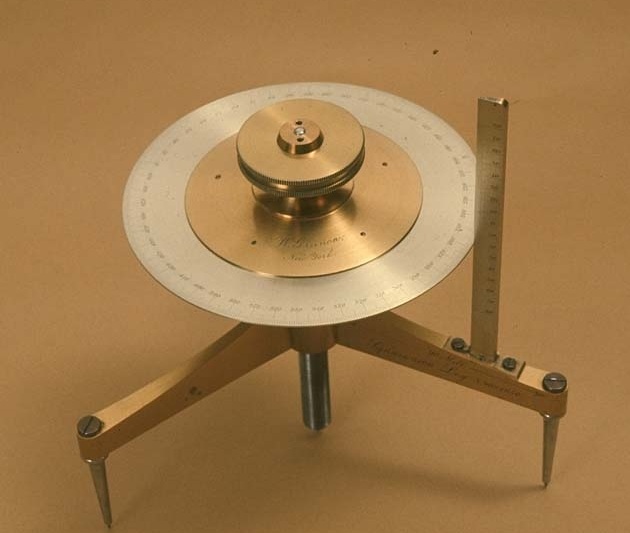
Grunow Spherometer, ca 1860, Smithsonian Institution negative number 75-2953.
The spherometer shown above was produced by instrument makers William and Julius Grunow in the 1860s, after they emigrated from the German lands to New York City. The instrument was donated to the Smithsonian's National Museum of American History (NMAH) in 1958 by the Department of Physics and Chemistry at the United States Military Academy at West Point, New York.
The complete collection of eight spherometers at NMAH can be viewed at
http://americanhistory.si.edu/collections/object-groups/spherometers.
Mathematical Treasure: Hewlett-Packard HP-28S Handheld Electronic Calculator from the AMS Centennial Meeting
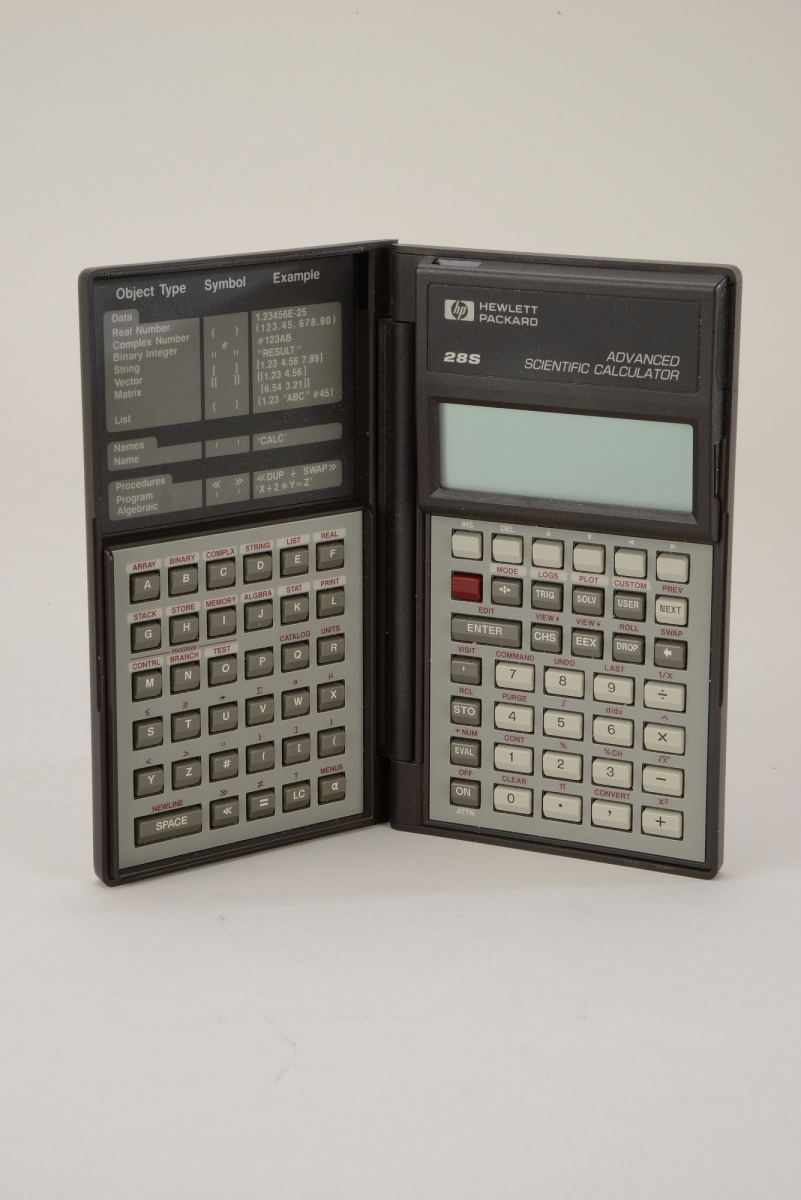
HP28S Handheld Electronic Calculator, Smithsonian Negative DOR2014-05134
By 1988, when Harvard professor of mathematics Andrew Gleason obtained this instrument at the banquet for the Centennial meeting of the American Mathematical Society, electronic calculators had transformed the way people did arithmetic and statistics. Slide rules, adding machines and calculating machines had all been displaced. This Hewlett-Packard calculator, like a few other contemporary machines, could graph functions as well as do arithmetic. Powerful programmable graphing calculators would become common in the mathematics classroom, and Gleason worked with others to produce curricula suited to the new technology.
To find out more about several hundred handheld electronic calculators in the collections of the National Museum of American History, see http://americanhistory.si.edu/collections/object-groups/handheld-electronic-calculators.
Mathematical Treasure: Hypotrochoid Kinematic Model by M. Schilling
During the latter half of the 19th century and into the 20th, educators and engineers used models to visualize mathematical curves and surfaces. Models that depict geometric curves produced by constrained motion were called kinematic models. One of the largest publishers of mathematical models, both static and kinematic, was the firm of Martin Schilling of Leipzig, Germany. The Smithsonian houses ten of these models, most from the University of Michigan. They fall roughly into two categories: linkages and models that produce trochoids.
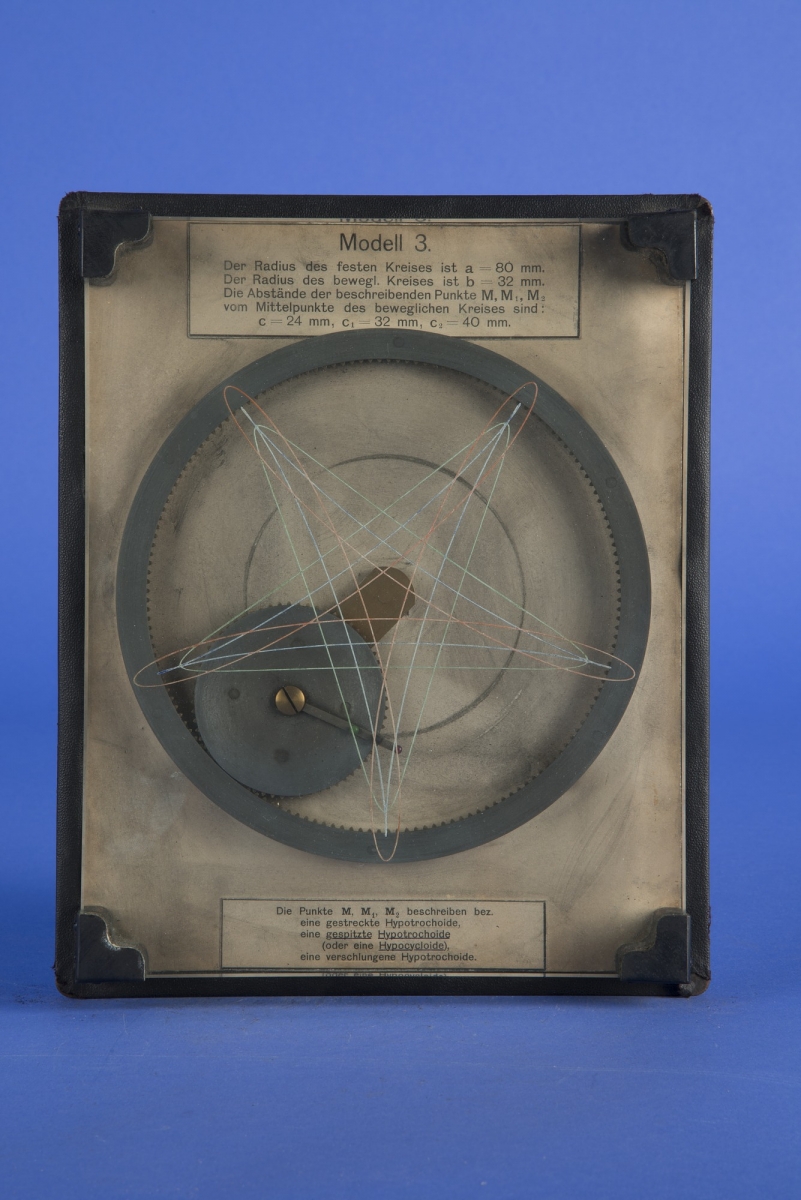
Hypotrochoids (ca 1900), kinematic model by Martin Schilling, series 24, model 3, number 331, Smithsonian Institution negative number DOR2013-50214.
This model produces hypotrochoids, curves formed by tracing a point on the radius or extension of the radius of a circle rolling around the inside of another stationary circle. Hypotrochoids are members of the family of curves called trochoids—curves that are generated by tracing the motion of a point on the radius of a circle as it rolls along another curve—and include the well-known cycloids. In this model, three hypotrochoids are generated. The blue point on the circumference of the disc traces a blue five-pointed star shape referred to as a hypocycloid. The green point on the radius of the disc traces a green curve inside the ring, and the red point on the extension of the radius of the disc traces a curve that extends past the radius of the ring.
By the early years of the 20th century, these types of models were losing popularity with educators. With the advent of computer aided design software, mathematical models are now museum pieces or curios in display cabinets in university mathematics or engineering departments.
The full set of the Smithsonian Schilling kinematic models can be found at http://americanhistory.si.edu/collections/object-groups/kinematic-models.
Mathematical Treasure: Japanese Protractor for the 1876 World's Fair
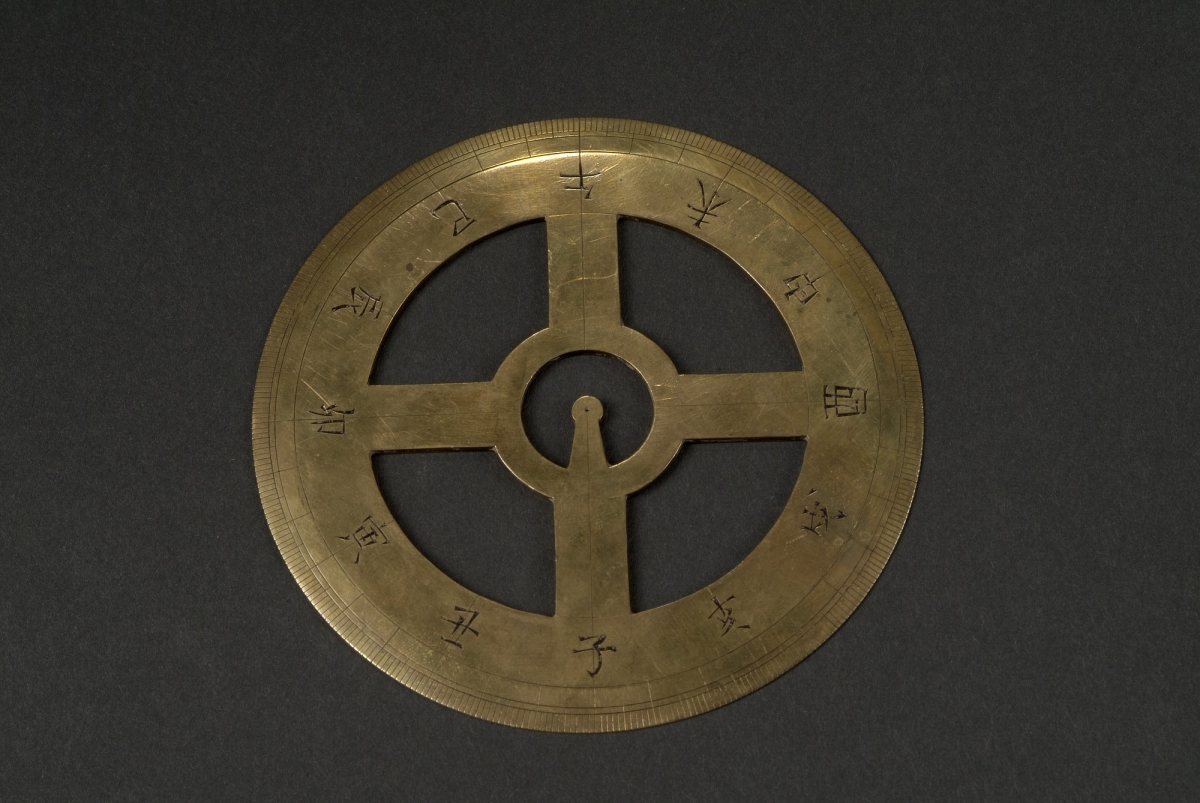
Japanese Protractor, 1876, Smithsonian Institution negative number 2003-35924.
After Commodore Matthew Perry negotiated a treaty between the United States and Japan in 1853–1854, the government of Japan engaged in efforts to demonstrate the nation could become a modern industrial and military power. For the 1876 World's Fair, the Centennial Exhibition in Philadelphia, the Japanese Empire Department of Education (established in 1870) prepared a large display of traditional mathematical instruments, mathematical instruments patterned on those used in Western Europe and the United States, and instruments that blended elements of multiple cultures. Thus, this protractor divides a circle into segments of 30° that are marked with Japanese characters for the twelve animals in the Chinese zodiac.
When the fair ended, John Eaton, the U.S. Commissioner of Education, arranged for the transfer of the entire exhibit to the Bureau of Education (then part of the Department of the Interior) for a planned museum. The museum closed in 1906 due to high maintenance costs, and much of the collection was transferred to the Smithsonian in 1910.
This object and other protractors from the Smithsonian's National Museum of American History are now shown and described at the website http://americanhistory.si.edu/collections/object-groups/protractors.
Index of Mathematical Treasures
Mathematical Treasure: Jean Lepine’s Adding Machine
The French mathematician and philosopher Blaise Pascal (1623–1662) designed a stylus-operated adding machine in 1645 that worked well but was not sold widely. In 1725, Jean Lepine, who may have been the king’s watchmaker and mechanic, designed a machine that was operated by springs instead of falling weights, although it still required a stylus. Its workings are discussed on a history of computing website, which links to a copy of Lepine’s paper about the device. This particular example was repaired in 1844 by Charles Xavier Thomas of Colmar.
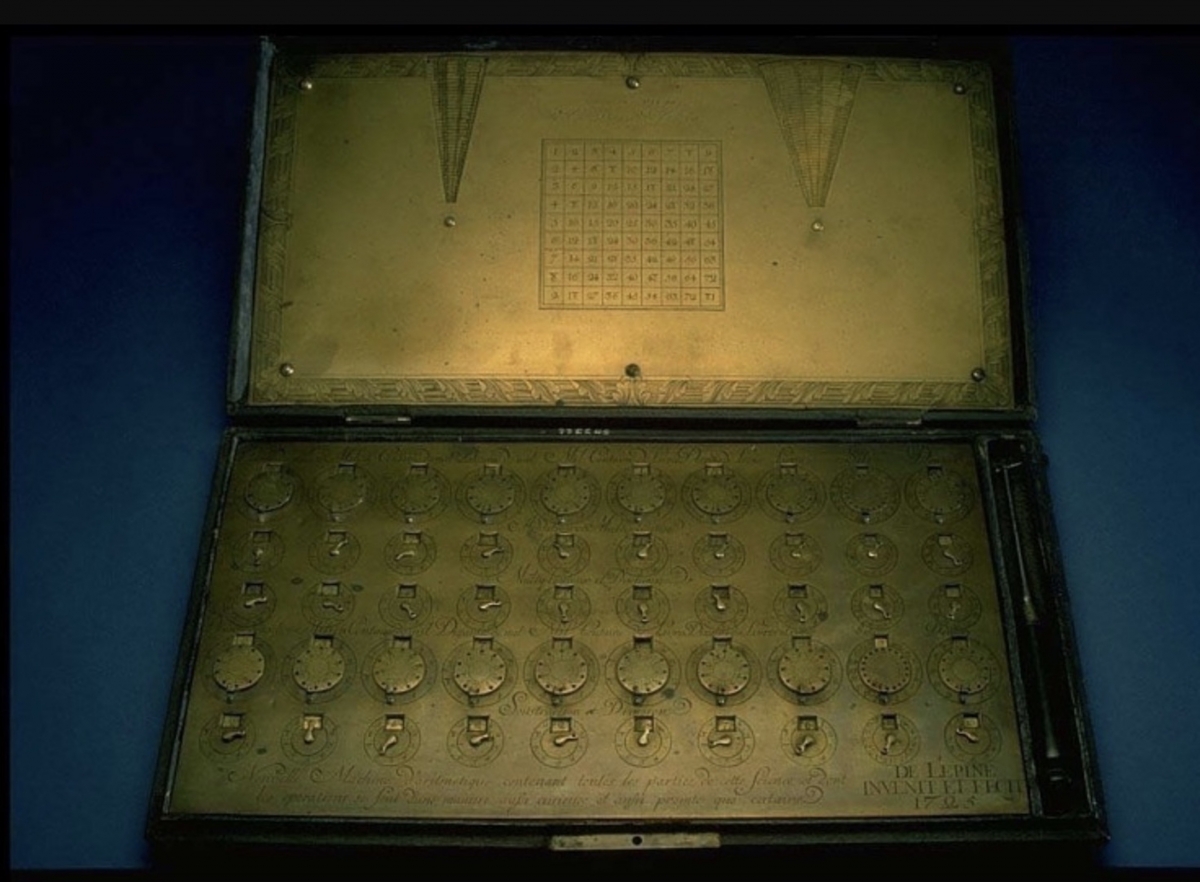
Lepine adding machine, 1725, Smithsonian Institution negative number NMAH-89-19705.
This object and other adding machines from the Smithsonian Institution’s National Museum of American History are shown at the website http://americanhistory.si.edu/collections/object-groups/adding-machines.
Mathematical Treasure: Jullien Models for Descriptive Geometry
Fortification was the cornerstone (so to speak) of military defense in medieval and Renaissance Europe, and its importance continued into the early modern period. So when Gaspar Monge (1746–1818) developed a new method for rendering architectural drawings, the French government quickly started teaching it at its premier military and scientific schools, while simultaneously making the technique a state secret. Descriptive geometry uses vertical as well as horizontal projections of a three-dimensional object to show the geometric properties of the object, such as angles of inclination and intersection, which are necessary for accurate architectural designs. Projection, in the form of relief drawings, was not new. Monge’s innovation was presenting both the front and top view on the same sheet of paper (front view or the vertical projection on the top half of the paper, top view or horizontal projection on the bottom half). This allowed the use of Euclidean geometry to find geometric properties of the object. Within a decade or two, descriptive geometry was no longer classified, and the teaching of descriptive geometry became common in French and other European technical colleges, as well as at West Point, the United States Military Academy. Starting with Monge’s text Géométrie descriptive (1799), texts on descriptive geometry began to be produced in the early 19th century.
One of these second-generation texts was Cours élémentaire de géométrie descriptive by the French academic A. Jullien. To accompany his text, Jullien constructed a set of 30 models, or reliefs.
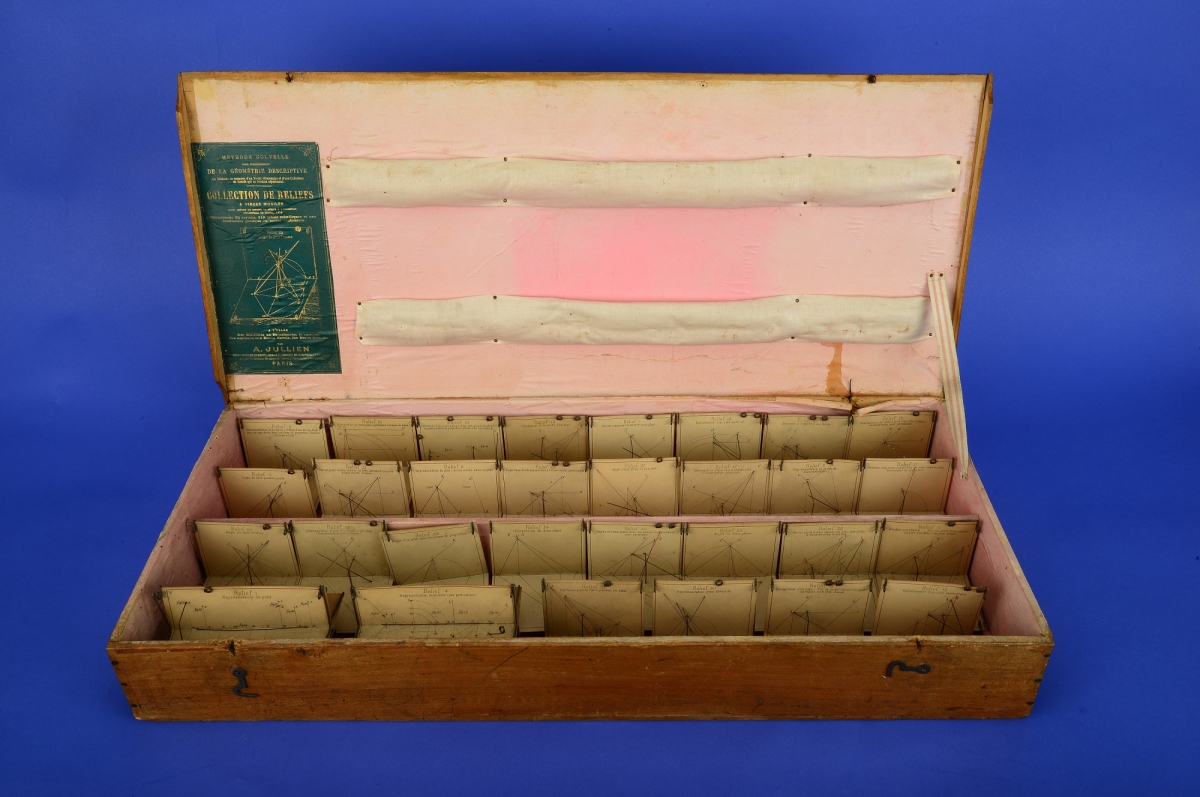
Box of 30 descriptive geometry models, ca 1880, Smithsonian Institution negative number DOR 2015-00774.
The reliefs show, in three dimensions, how the descriptive geometry plans were produced. They start with simple constructions, such as the representation of points and lines, and culminate in the representation of a generalized pyramid. The models are accompanied by a pamphlet describing each model in detail and were designed to follow the lessons in the text, which means that an instructor would have used them for illustration in the classroom. These models thus functioned as the Maple or Mathematica 3-D renderings of their day.
Relief 29 (below) shows the line of intersection of two planes, both of which are perpendicular to the vertical plane. The line of intersection is represented by the wire coming out of the vertical plane toward the viewer.
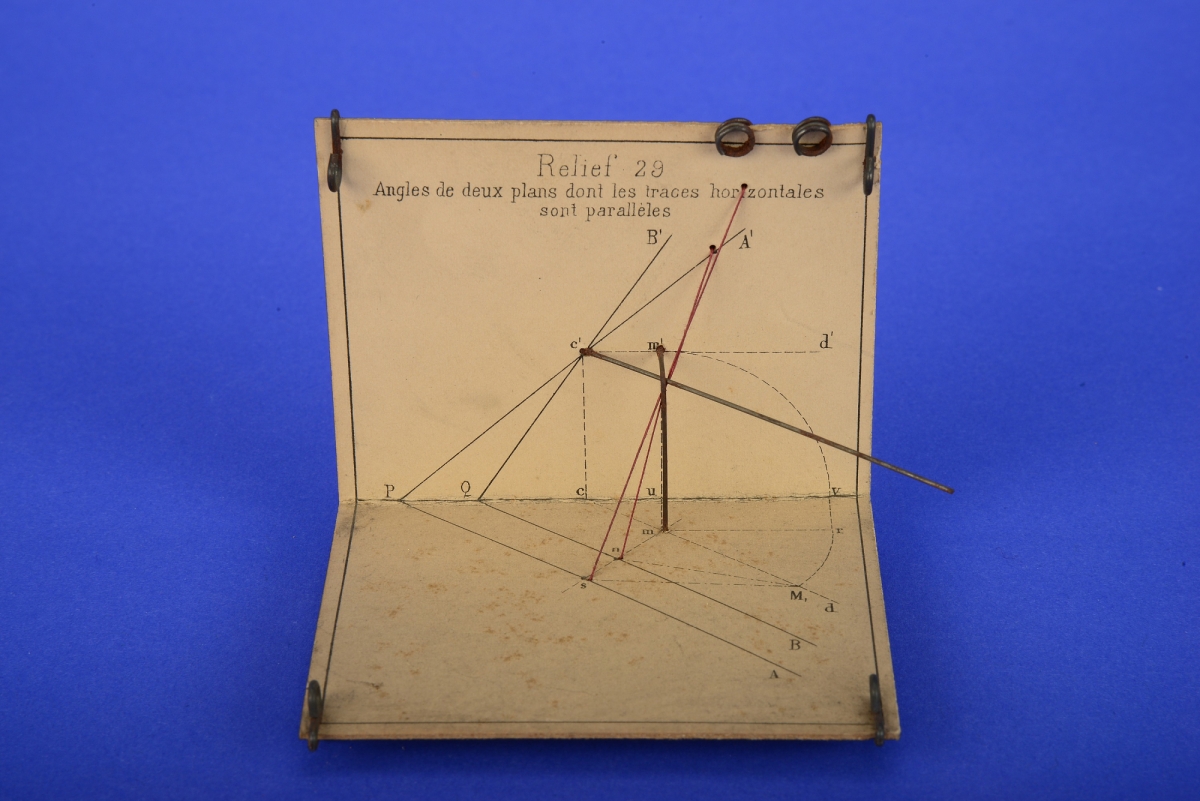
Relief 29, angle of intersection between two planes, Smithsonian Institution negative number DOR 2015-00810.
The Smithsonian National Museum of American History owns a complete set of Jullien models of descriptive geometry, produced around the mid to late 1880s. The third edition of Jullien’s text (1881) is available on Google Books and can be used in conjunction with the images of the models to learn the constructions of descriptive geometry. Information about the Jullien Models, as well as the pamphlet and descriptions and images of each relief, can be found at the online collections of the Smithsonian National Museum of American History, http://americanhistory.si.edu/collections/object-groups/geometric-models-jullien-models-for-descriptive-geometry.
Mathematical Treasure: Keuffel & Esser Trammel Ellipsograph
Ellipsographs are, as the name implies, devices for drawing ellipses. Ellipsographs were used by surveyors, engineers, draftsmen, architects and machinists to produce technical drawings. Many elements of these drawings require rendering a circle in perspective, which results in an ellipse. For example, architectural elements such as windows and arches are elliptical.
There are several methods for drawing ellipses by hand, the most common being the two pins and a loop of string approach, which works surprisingly well. There are also several methods for drawing them mechanically. German artist Albrecht Dürer, known for his precise perspective drawings, invented a compass to draw ellipses in 1540.
Most ellipsographs are Trammels of Archimedes, in which two sliders move perpendicularly to each other, constrained by a connecting bar. By adjusting where the sliders are attached to the bar, ellipses of various eccentricities can be generated. A pencil attached to the end of the bar traces the ellipse. This model was manufactured (or imported) in approximately 1930 by the Keuffel & Esser Company of New York and is marked “Keuffel & Esser Co N.Y. Switzerland.” It is a precision device used by draftsmen and engineers. It can draw ellipses of major axis 6 to 18 inches in length.
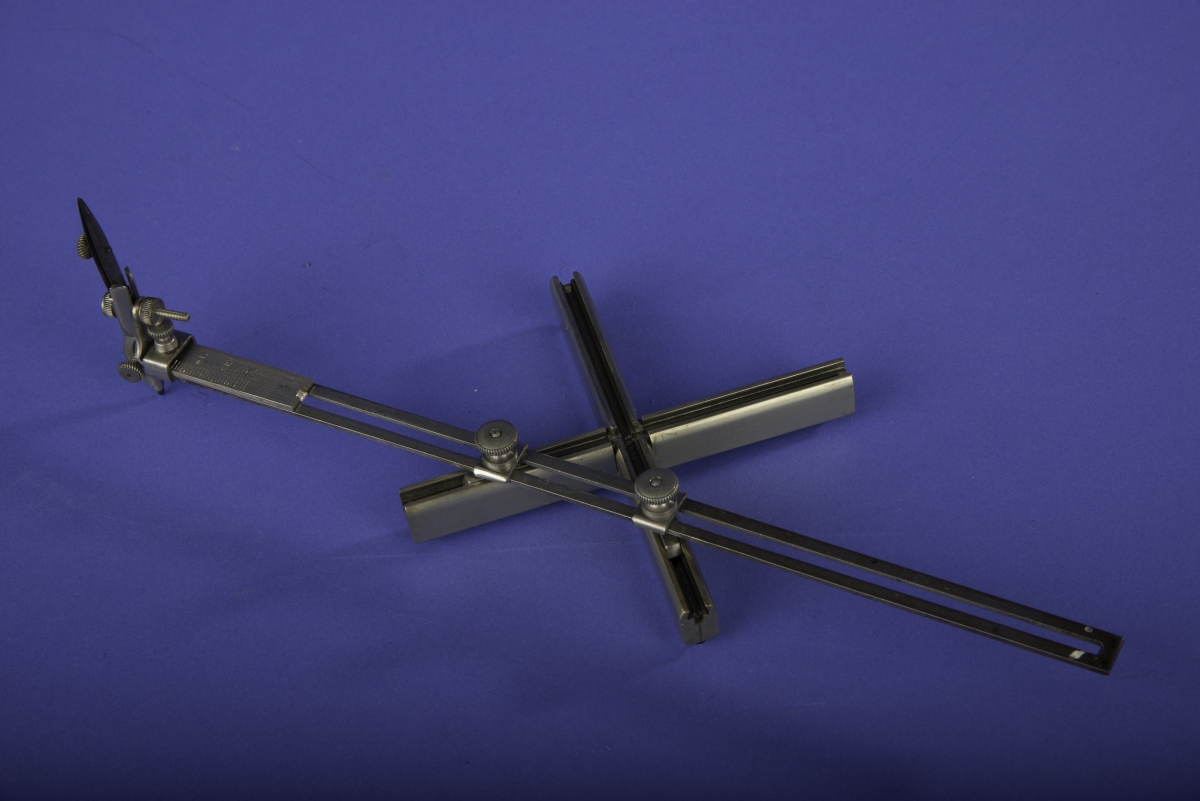
Keuffel & Esser Trammel Ellipsograph, ca 1930, Smithsonian Institution negative number DOR2013-00718.
This device was a gift from Brown University in 1973. The Smithsonian also owns ellipsographs of much more complicated design. All of them were built between the mid-19th and early 20th centuries. All eight ellipsographs from the collection of the Smithsonian Institution’s National Museum of American History are shown at the website http://americanhistory.si.edu/collections/object-groups/ellipsographs.
Elsewhere in Convergence, four ellipse drawers, including string and trammel drawers, are illustrated dynamically in "Curve Drawing Then and Now." The remaining ellipse drawers from "Curve Drawing Then and Now" are due to Proclus and Frans van Schooten. Van Schooten's ellipse drawer is illustrated on page 317 of his 1657 Five Books of Mathematical Exercises. Another illustration of Van Schooten's ellipse drawer from this book can be seen in the Convergence article, "Van Schooten's Ruler Constructions."
Mathematical Treasure: Maurice Kidjel's Ratio Cali-Pro
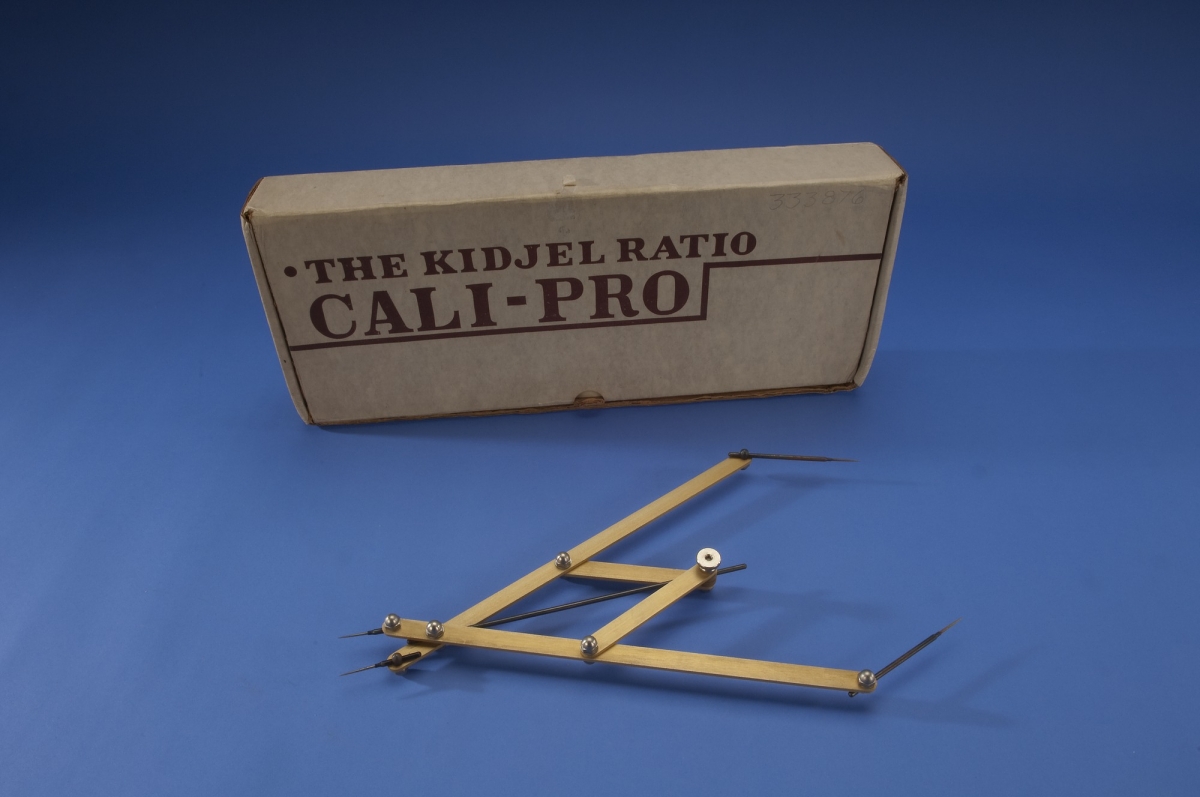
Kidjel Ratio Cali-Pro Proportional Dividers, ca 1962, Smithsonian Institution negative number DOR2012-2554.
Sometimes, people's enthusiasm for mathematics can lead them into the territory of mathematical cranks. Maurice Kidjel (1888–1976) was a well-regarded painter of portraits and nature scenes who lived in Honolulu. In the late 1950s, he researched proportions and concluded that the ratio most pleasing to the eye is 1:5.333. He devised a drawing instrument that is essentially a specialized form of proportional dividers permanently set at this ratio. Artists, draftsmen, letterers, and others could create drawings by setting the long needles so that they spanned the width of the large part of the drawing, and then turning the dividers over and using the short needles to make a small part of the drawing that was in proportion to the large part of the drawing.
Although the device was never as popular as traditional proportional dividers, which could be set to multiple proportions, it did sell relatively widely in the 1960s and 1970s. Kidjel, however, tried to push his invention further by claiming that the 1:5.333 ratio was the key to solving the three classical Greek construction problems (doubling the cube, trisecting an angle, squaring the circle) with a compass and straight edge. His solutions rested on a false definition of π and thus were not mathematically valid. Yet, his ruminations on the so-called "universal ratio" came to the attention of other prominent Hawaiians, including the state's first full member of Congress, Daniel Inouye, who read a tribute to the ratio into the Congressional Record on June 3, 1960, and Church College of Hawaii President Richard T. Wooton, who discussed Kidjel's work in a 1963 lecture on the nature of God.
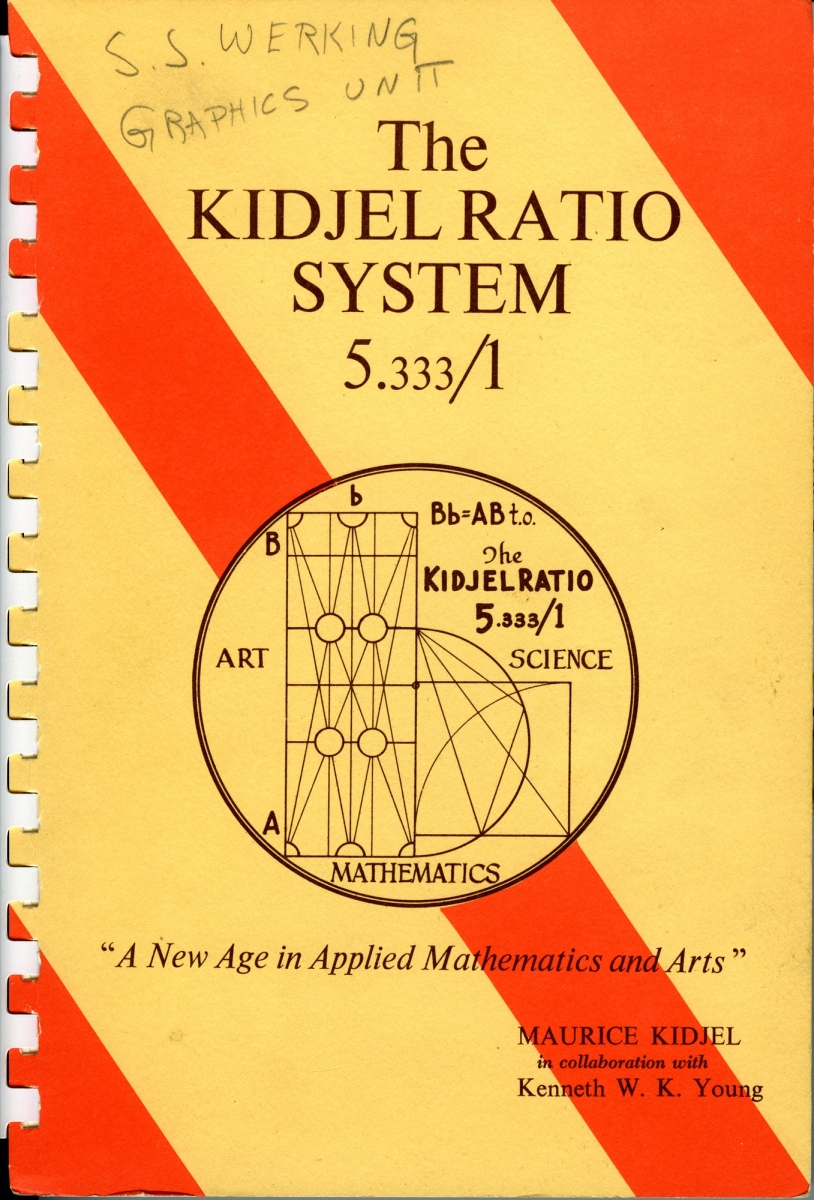
Kidjel described his faulty ideas about mathematics in the instruction manual for his reliable instrument, published in 1962 with his business partner, Kenneth W. K. Young, Smithsonian Institution negative number AHB2012q05985.
This object and more standard dividers and drawing compasses from the Smithsonian's National Museum of American History are now shown and described at the website http://americanhistory.si.edu/collections/object-groups/dividers-compasses.
Mathematical Treasure: Model Cash Register Designed by the Ritty Brothers

Ritty Model #1 Cash Register, made by 1904, Smithsonian Institution negative number 73-3169.
In the second half of the 19th century, merchants increasingly hired strangers to work in their stores. To tally purchases and track money passing through their businesses, they turned to cash registers. This is the prototype for a cash register designed by the brothers James and John Ritty of Dayton, Ohio. Their machine had a large, clock-like face and a row of keys for entering amounts from 5 cents to 95 cents (by fives) and from $1 to $9. A mechanism inside the machine recorded total sales. Patents taken out by the Rittys became the basis of the firm of National Cash Register, which went on to sell much more elaborate cash registers worldwide. This model was exhibited by NCR in 1904 as an example of the beginning of their business.
For a more complete discussion of this and other cash registers in the collections of the Smithsonian’s National Museum of American History, see http://americanhistory.si.edu/collections/object-groups/cash-and-credit-registers.
Mathematical Treasure: Model for Soap Film Minimal Surface by Brill
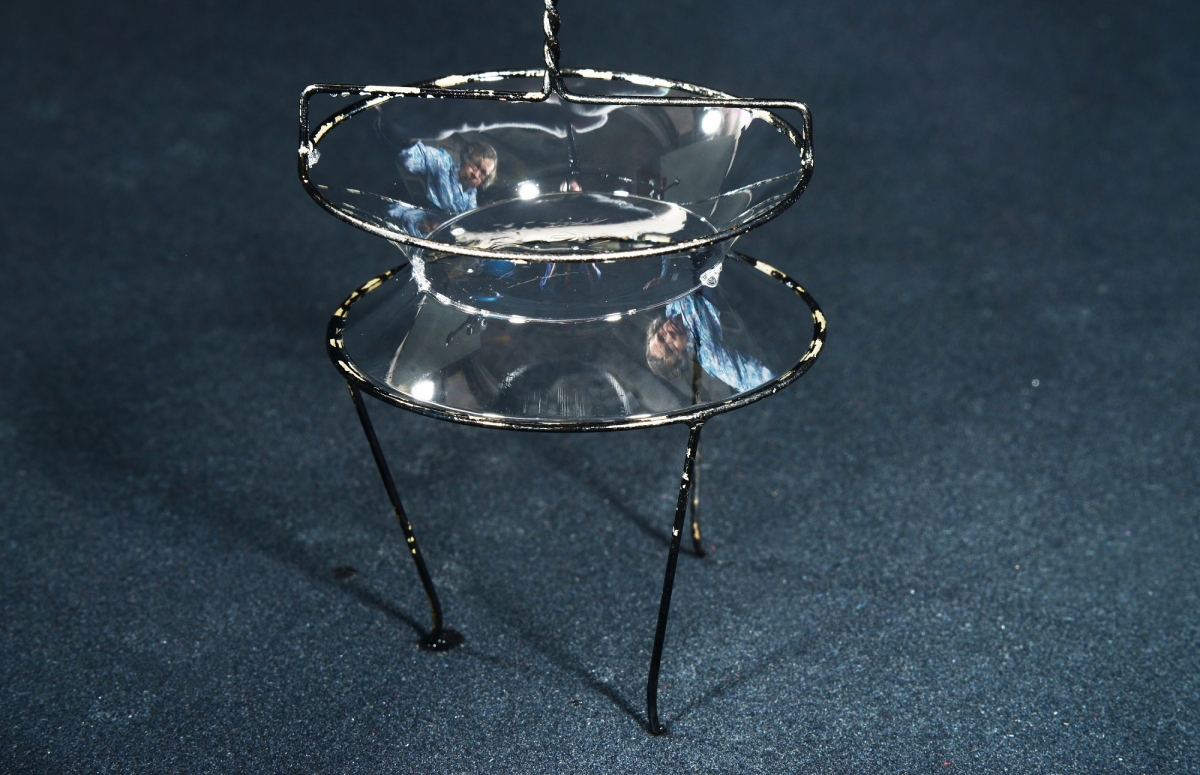
Wire model – Soap Film Minimal Surface, ca 1892, Smithsonian Institution negative number NMAHAHB2017q018046
Particularly in the mid-19th century, mathematicians and physicists explored the mathematical properties of soap films. Ideally, the surface formed when a closed wire frame is dipped in soapy water is a minimal surface, that is to say the surface of smallest area of all the surfaces bounded by the frame. This example has two circular rings, one of which sits atop the other. The surface formed by the soap is a catenoid. The model was one of a set designed by students of German mathematician Alexander Brill (1842–1935) and manufactured by his brother Ludwig Brill of Darmstadt. This example was exhibited at the World’s Fair of 1893, held in Chicago.
Images of a series of such models by Brill, with appropriate films, may be examined at https://americanhistory.si.edu/collections/object-groups/geometric-models-minimal-surfaces-as-soap-films.
Mathematical Treasure: Model of Elongated Pentagonal Pyramid
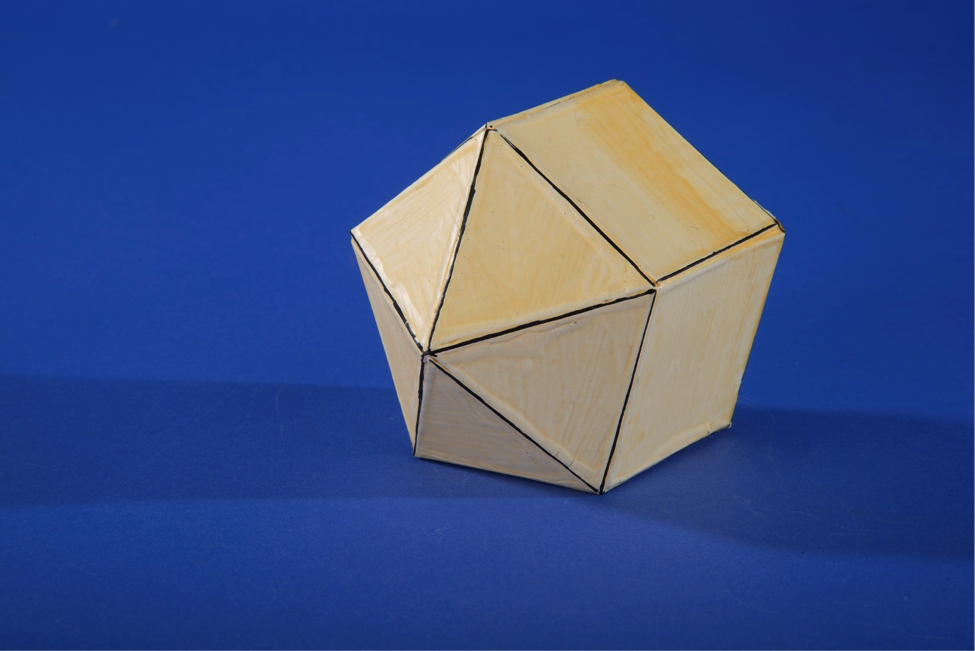
Model of an Elongated Pentagonal Pyramid, Smithsonian Institution negative number DOR2014-00726
In 1966, fifty years ago, the American mathematician Norman W. Johnson, a student of H.S.M. Coxeter at the University of Toronto in Canada, published an enumeration of the convex polyhedra with regular faces. These included the Platonic solids, the Archimedean solids, an infinite family of prisms with square sides, an infinite family of antiprisms with equilateral triangles as sides, and a group of other polyhedra now known as the Johnson solids. This paper model of a Johnson solid shows a pentagonal prism with a pyramid erected on one of its pentagonal faces. It was made by Michael Berman, an amateur mathematician in Pittsburgh, who also made models of other regular-faced convex polyhedra. These models are now in the collections of the National Museum of American History.
For further information and descriptions of all of Berman’s models see http://americanhistory.si.edu/collections/object-groups/geometric-models.
Mathematical Treasure: Model of Oblique Spherical Triangle on the Earth’s Surface
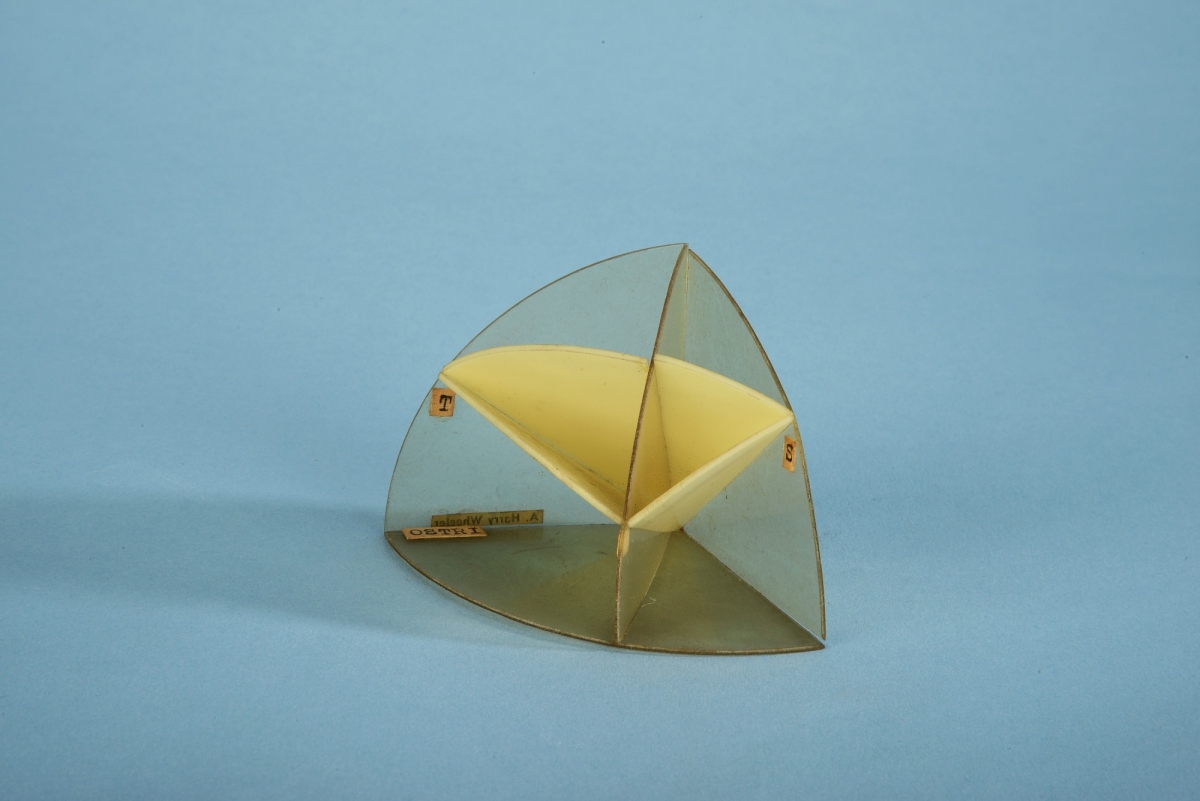
Wheeler’s model of a spherical triangle, 1945, Smithsonian Institution negative number NMAH-DOR2015-00457
Mathematical people from ancient astronomers to modern navigators have calculated the arc lengths and angles of triangles on a sphere. Some used special globes and instruments to teach the subject. Massachusetts high school teacher A. Harry Wheeler (1873–1950), who made hundreds of models of polyhedra and other mathematical surfaces, made models for spherical trigonometry that can be dated from 1915 to 1945. He was particularly interested in the topic during World War II, when he taught mathematics at Clark University for the U.S. Army. This 1945 model shows four quadrants of the celestial globe. One represents the equator. The other three parts are perpendicular to the equator through the pole. One passes through point labeled T (Tokyo), another through point H (Honolulu), and the third through point S (San Francisco). A trihedral angle made from pieces of white plastic is bounded by the spherical triangle joining the three points. Several of Wheeler’s models for spherical trigonometry, as well as other instruments related to the subject, can be seen at https://americanhistory.si.edu/collections/object-groups/trigonometry-on-the-sphere.
Mathematical Treasure: Modern Chinese Abacus
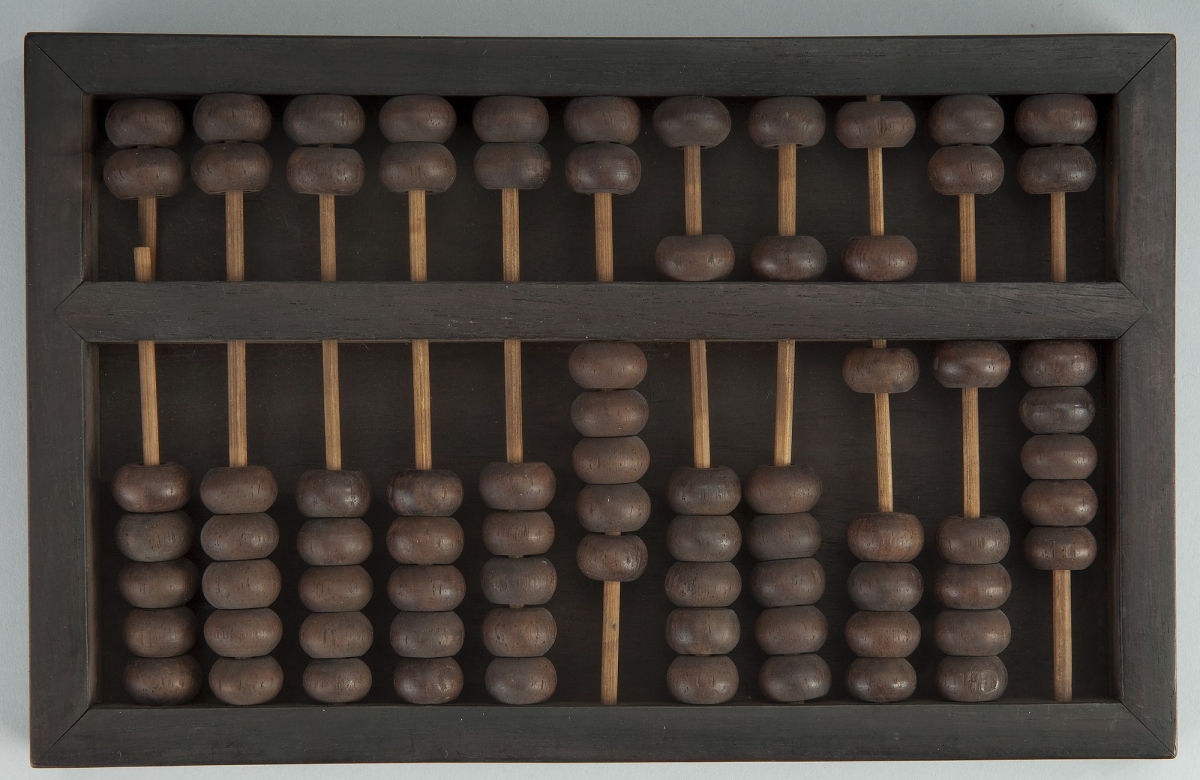
Chinese Abacus, ca 1925, Smithsonian Institution negative number DOR 2010-0104.
The abacus is a computing device on which arithmetic calculations are performed by sliding counters (beads, pebbles, or flat discs) along rods, wires or lines. The instrument may have originated in the Middle East before the time of Christ. Small stones known as calculi, from the Greek khalix, pebble, were moved along lines drawn in stone or sand. Our modern terms “calculate” and “calculus” come from the term calculi, while the word “abacus” comes from a Greek word meaning a board or slab, or a calculating table.
The abacus has taken many forms over the centuries. In Medieval and Renaissance Europe, merchants commonly did calculating by moving wooden or metal counters along lines drawn on a wooden table known as counting board, a counter-board, or a reckoning-board. The term “counter” eventually came to refer not only to an object used in calculations but also to the place in a store where transactions are carried out.
By the eighteenth century, the abacus was well established in China and Russia. In the late nineteenth and early twentieth centuries, western scientists and mathematicians sometimes exhibited abaci as examples of eastern culture, This is one such abacus, from the mathematics department of Brown University. The beads on the rods in this abacus represent numbers in base ten, reading from right to left as 1s, 10s, 100s, etc., as in European notation. In the Chinese form of the instrument, two beads above the cross-bar each represent five and those below it represent one. Five can be represented by five one-beads brought up to the cross-bar or by one five-bead brought down. Thus, the abacus shown in the photograph represents the number 555,615. Final answers are usually represented by the smallest possible number of beads—five one-beads would be replaced by one five-bead.
This object and other abaci from the Smithsonian Institution’s National Museum of American History are shown at the website http://americanhistory.si.edu/collections/object-groups/the-abacus-the-numeral-frame-and-counters.
Mathematical Treasure: Moffett Register for Recording Alcohol Sales
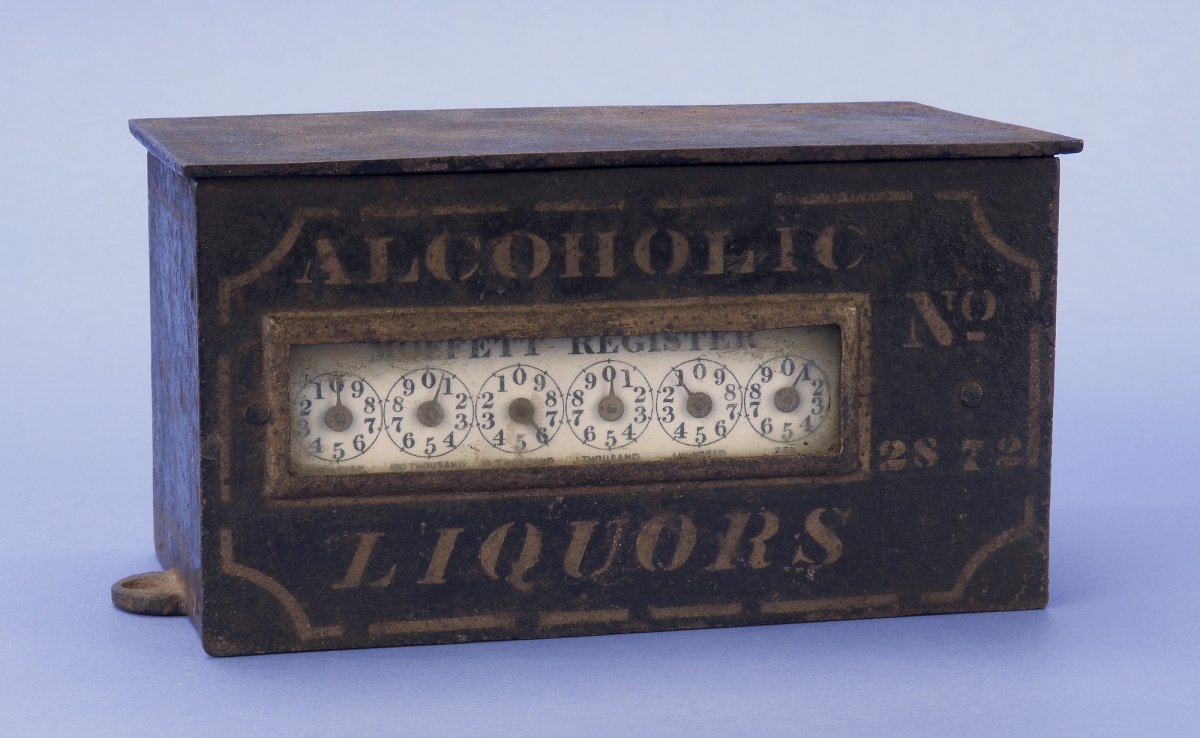
Moffett Register, 1877, Smithsonian Institution negative number DOR 2012-1002-2267.
From ancient times until well into the Renaissance, scribes carried out calculations by moving tokens or counters along lines. More recently, mechanical counters have been used to record everything from distances to revolutions of a shaft to sales.
In the spring of 1877, to pay the interest on the public debt, the state of Virginia passed a law suggested by State Senator Samuel H. Moffett of Harrisonburg. Every liquor dealer and saloon in the state was to be equipped with a so-called Moffett Register to record sales of liquor, allowing state tax collectors to know taxes due. This is an example of a Moffett Register.
This object and other mechanical counters from the Smithsonian Institution’s National Museum of American History are shown at the website http://americanhistory.si.edu/collections/object-groups/counters.
Mathematical Treasure: National Class 3000 Bookkeeping Machine
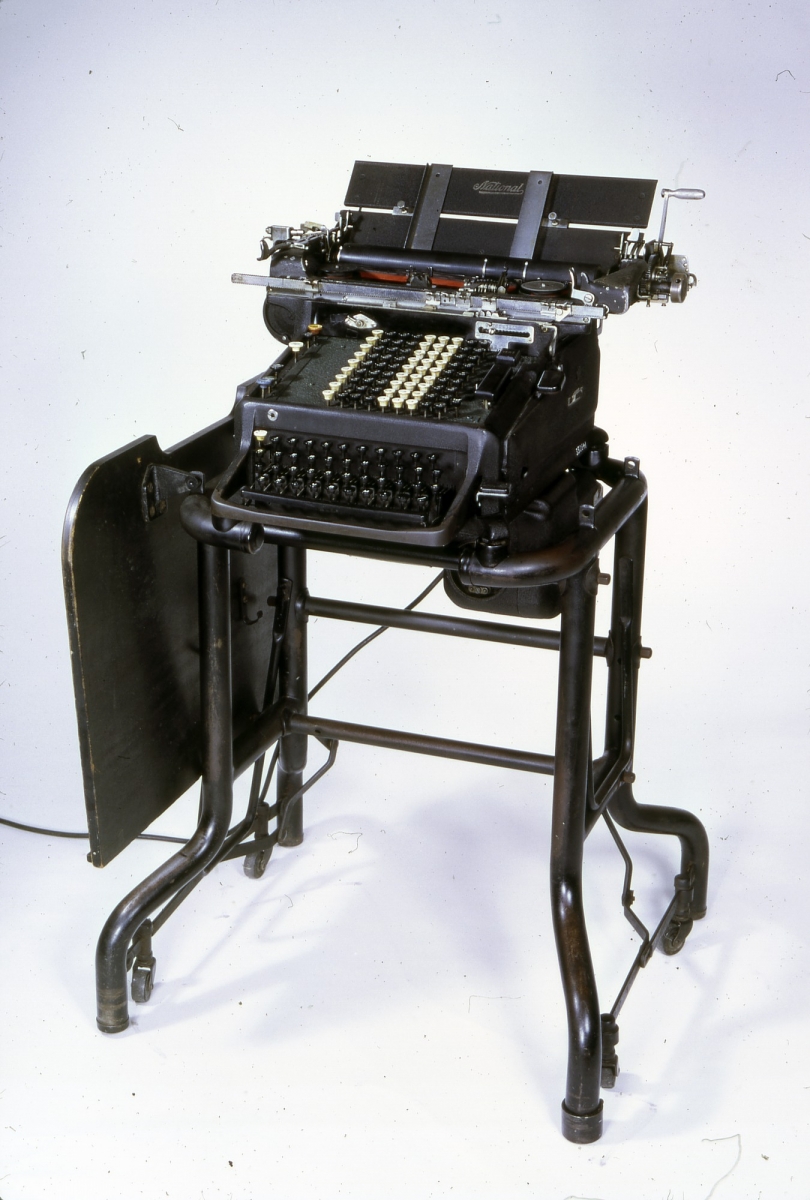
Class 3000 NCR Bookkeeping Machine, 1938, Smithsonian Institution negative number 73-9085.
Beginning in 1929, the National Cash Register Company of Dayton, Ohio, manufactured machines that could not only do arithmetic but print a full range of text. The astronomer Leslie J. Comrie figured out how to use machines of this type to prepare mathematical tables for the British Nautical Almanac. He was able to produce on a modified bookkeeping machine what Charles Babbage had hoped to do with a difference engine. This is not the bookkeeping machine used by Comrie, but it is the type of machine he used.
This object and other bookkeeping machines from the Smithsonian Institution’s National Museum of American History are shown at the website http://americanhistory.si.edu/collections/object-groups/bookkeeping-machines.
Mathematical Treasure: Nels Ockerlund's Patent Model for a Combination Ruler
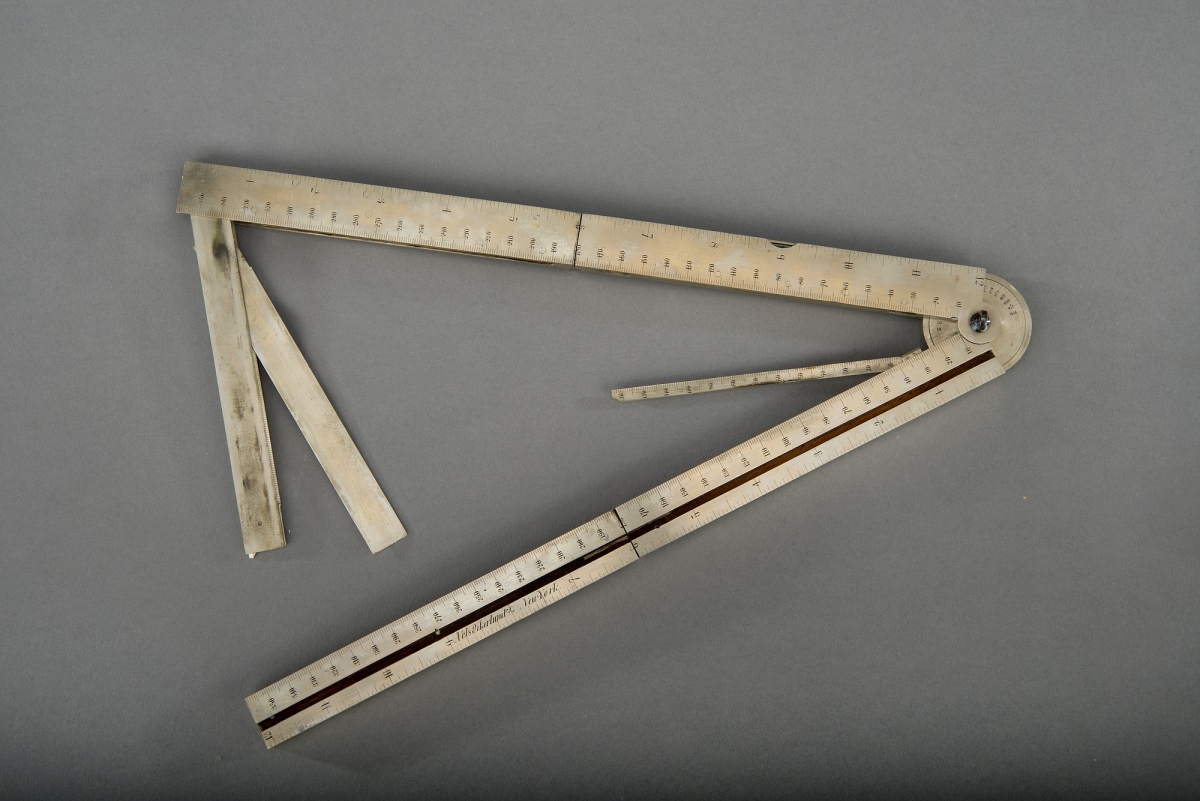
Nels Ockerlund, Patent Model for Combination Rule, Protractor, and Calculating Device, 1870, Smithsonian Institution negative number DOR2013-16385.
The U.S. Patent Office collected about 200,000 models to accompany the 246,000 patent applications received by the office between 1790 and 1880 before it was decided that 3-D mock-ups would no longer be required from inventors. Thousands of models had burned in a fire at the Patent Office Building in 1877, but thousands remained to be stored and maintained. The U.S. Congress attempted to disburse the collection in 1908 and 1926, transferring over 16,000 of the patent models to the Smithsonian.
One of these objects was designed by Nels Ockerlund (1837–1903), an emigrant from Sweden who settled in New York City. Combination instruments were popular with draftsmen, builders, and engineers, so Ockerlund devised a tool that measured distances of up to 24 inches, measured angles, solved problems relating to ratios, assisted in finding the area of triangles when the lengths of three sides are known, and added three-digit numbers. The instrument folded up so that users could easily keep it in a pocket or in a case of drawing instruments.
This object and other rulers, scales, and length measures from the Smithsonian's National Museum of American History are now shown and described at the website http://americanhistory.si.edu/collections/object-groups/scale-rules.
Mathematical Treasure: Objects Related to Women Mathematicians
Most of the items in the Smithsonian collections that relate to women mathematicians are connected with pioneering women who joined the growing American mathematical community in the first half of the 20th century. Many of these items were collected in connection with a 1981 meeting sponsored by the Division of Mathematics of the National Museum of American History (NMAH) that honored American women who received doctorates in mathematics prior to World War II.
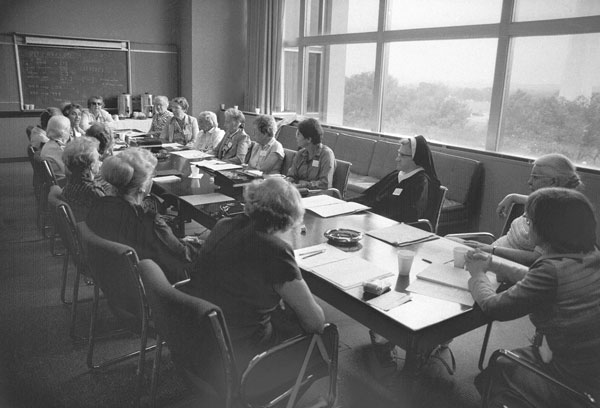
Eighteen women with PhDs in mathematics at the NMAH in 1981, Smithsonian Institution negative number 81-11284-13.
The objects in the collection illustrate diverse aspects of the personal and professional lives of several women mathematicians. Among these mathematicians are Olive C. Hazlett, a leading American mathematician of the 1920s who had an interest in music and puzzles; Grace Murray Hopper, whose illustrious career in computer science began in the Navy; Sister M. Helen Sullivan, whose professional activities centered around her teaching of mathematics; Frances E. Baker, one of quite a number of women mathematicians related or married to another mathematician, who was the daughter of Richard P. Baker, a well-known maker of mathematical models; and, finally, Daina Taimina, a current-day mathematician who crochets mathematical models.
A more detailed description of the collection can be seen at the website http://americanhistory.si.edu/collections/object-groups/women-mathematicians.
Mathematical Treasure: Paper Model of an Elliptic Paraboloid
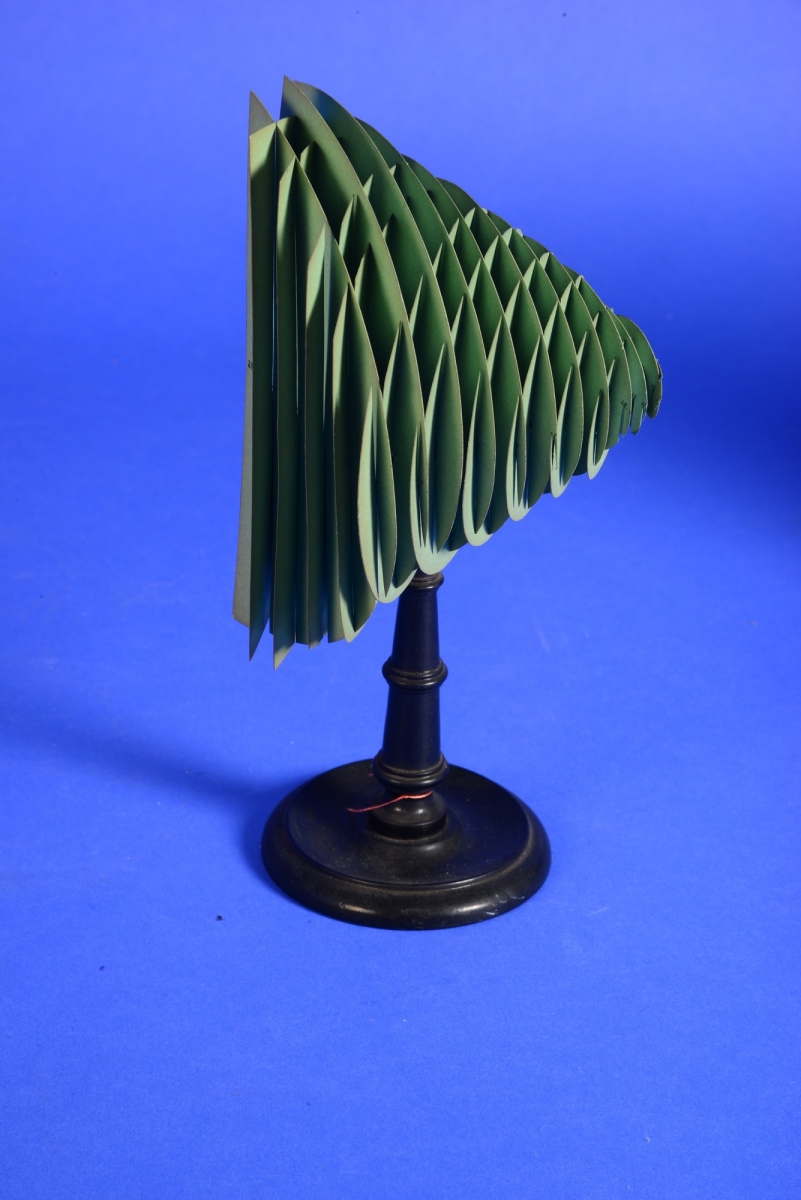
Brill Model of an Elliptic Paraboloid, 1892, Smithsonian Institution negative number NMAH-AHB2017q014188
The Danish-born mathematician Olaus Henrici (1840–1918) studied engineering and then mathematics in Germany, settling in England in 1865. Henrici first worked as an engineer but then taught at University College London and, from 1884, at the Central Institution in South Kensington. At both schools, he arranged space for the construction of mathematical models. In 1873, his interlocking paper model of an elliptic hyperboloid was exhibited at a meeting of mathematicians in Göttingen. Alexander Brill (1842–1935) of Munich attended the meeting and was much impressed. Brill designed a series of such paper models, almost all made up of circular discs and arcs of discs. He apparently first simply displayed these, but by 1888, his brother, the publisher Ludwig Brill, was selling them as “Carton Models.” This was the first of numerous series of mathematical models that L. Brill and his successor Martin Schilling published over the next decades. This example of a model from the series was exhibited at the 1893 World’s Fair in Chicago and then sold to Wesleyan University. Several paper models of second-order surfaces, including this one, are shown at https://americanhistory.si.edu/collections/object-groups/geometric-models-degree-two-paper.
Mathematical Treasure: Plane Dissection of a Square Transformable into a Regular Pentagon Transformable into a Regular Hexagon
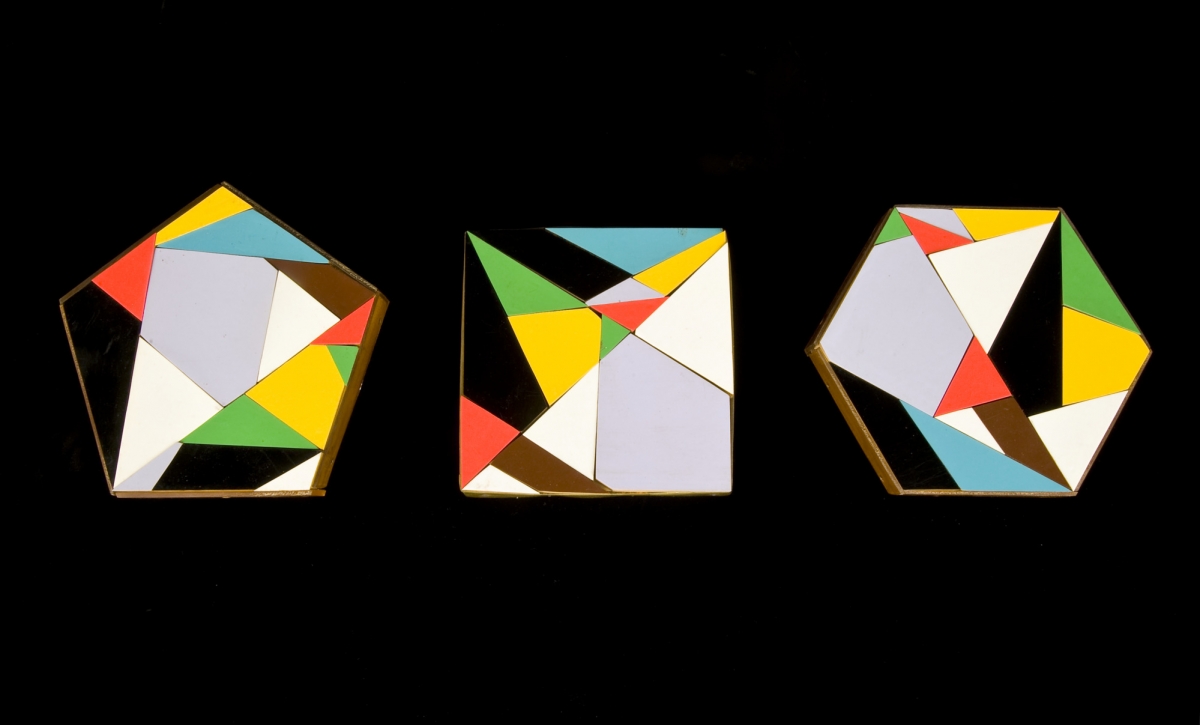
Three Plane Dissections, each made with the same 15 shapes, 1931, Smithsonian Institution negative number NMAH-JN2012-0951
Any two polygons of equal area can be divided into a finite number of polygonal pieces that can be arranged to form either polygon. This result was well known from the mid-19th century. Mathematical model maker A. Harry Wheeler (1873–1950), a high school teacher in Worcester, Massachusetts, took great delight in developing models of dissected polygons that could be rearranged in interesting ways. Surviving notes from the early 1930s indicate that Wheeler designed models of relatively complicated plane dissections for his own pleasure. Mindful of the popularity of jigsaw puzzles in the Depression years, he also made and encouraged his students to make dissections of simpler forms. Some of these models were hinged at vertices.
The three examples in the photograph show a plane dissection with fifteen pieces that can be arranged to form three different regular polygons. Wheeler’s other plane dissections all had fewer pieces. For an account of these three models, as well as Wheeler’s other plane dissections, see the National Museum of American History web object group at https://americanhistory.si.edu/collections/object-groups/geometric-models-plane-dissections.
Mathematical Treasure: Polar Planimeter Invented by Jacob Amsler
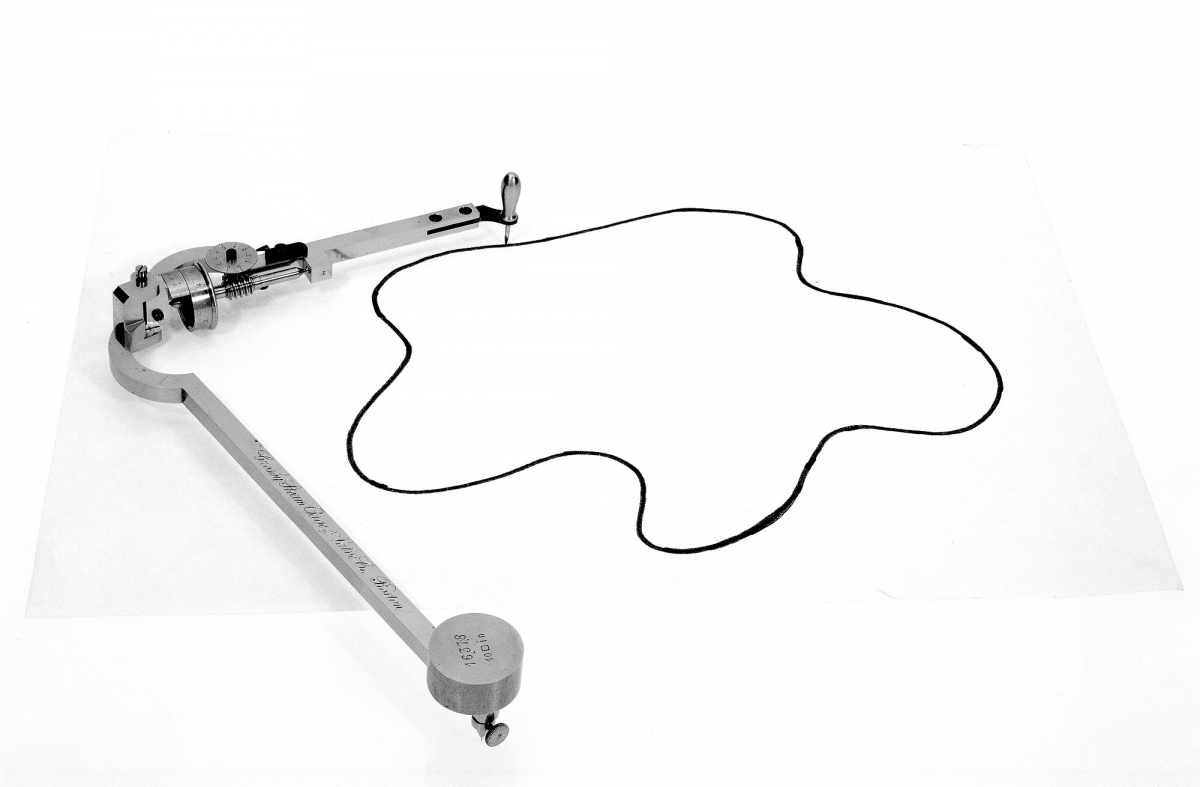
Amsler Type 2 Polar Planimeter, Sold by Crosby Steam Gage & Valve, 1880s, Smithsonian Institution negative number SIA-73-1252.
Swiss mathematician Jacob Amsler (1823–1912) was aware of other efforts to develop planimeters, mathematical instruments that allow users to determine the area of a curved region by tracing its boundary. By 1854, he had simplified earlier designs into two arms connected with a pivot. One arm was anchored at the end away from the pivot, and one arm traced the drawing. Because the pivot and both arms can move around the anchor, the motion of the tracer arm is graphed with polar coordinates instead of linear xy-axes. Amsler's device therefore was called a polar planimeter.
Amsler then established a workshop in Switzerland to manufacture planimeters. By the 1910s, his firm had sold 50,000 instruments, both directly to users and to retailers such as Crosby Steam Gage & Valve of Boston. In the United States, polar planimeters were particularly popular for measuring the areas of diagrams produced by steam engine indicators, devices attached to steam engines to measure their horsepower and identify potential problems inside the engine. Charles W. Batchelor (1845–1910) used the planimeter pictured here in his work as one of Thomas Alva Edison's chief assistants.
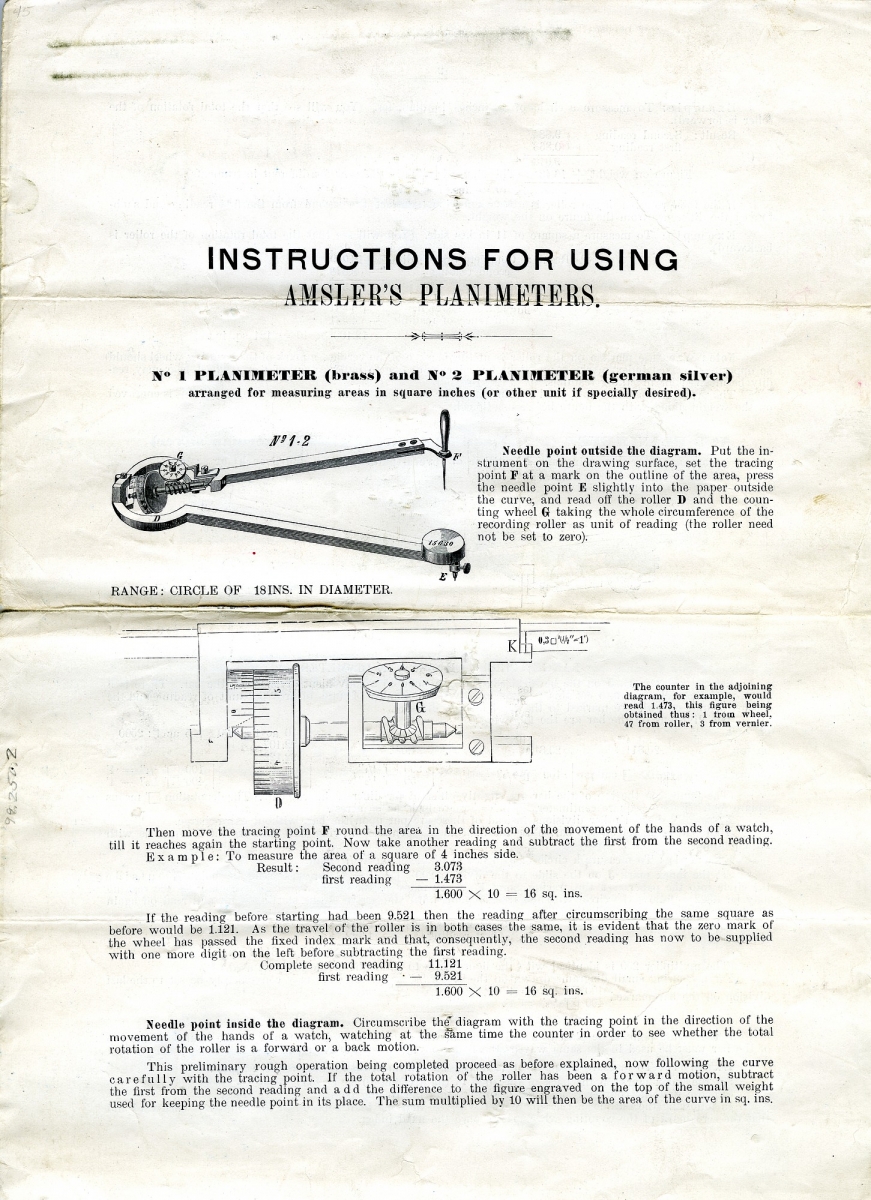
Brochures that functioned both as advertisements and instruction cards were often distributed with Amsler polar planimeters. This example depicts the nine types of polar planimeter manufactured by Amsler's firm in Schaffhausen, Switzerland, and was printed after 1912. Smithsonian Institution negative number AHB2013q009202.
This object and other planimeters from the Smithsonian's National Museum of American History are now shown and described at the website http://americanhistory.si.edu/collections/object-groups/planimeters.
Index of Mathematical Treasures
Mathematical Treasure: Portion of the Bush Product Integraph
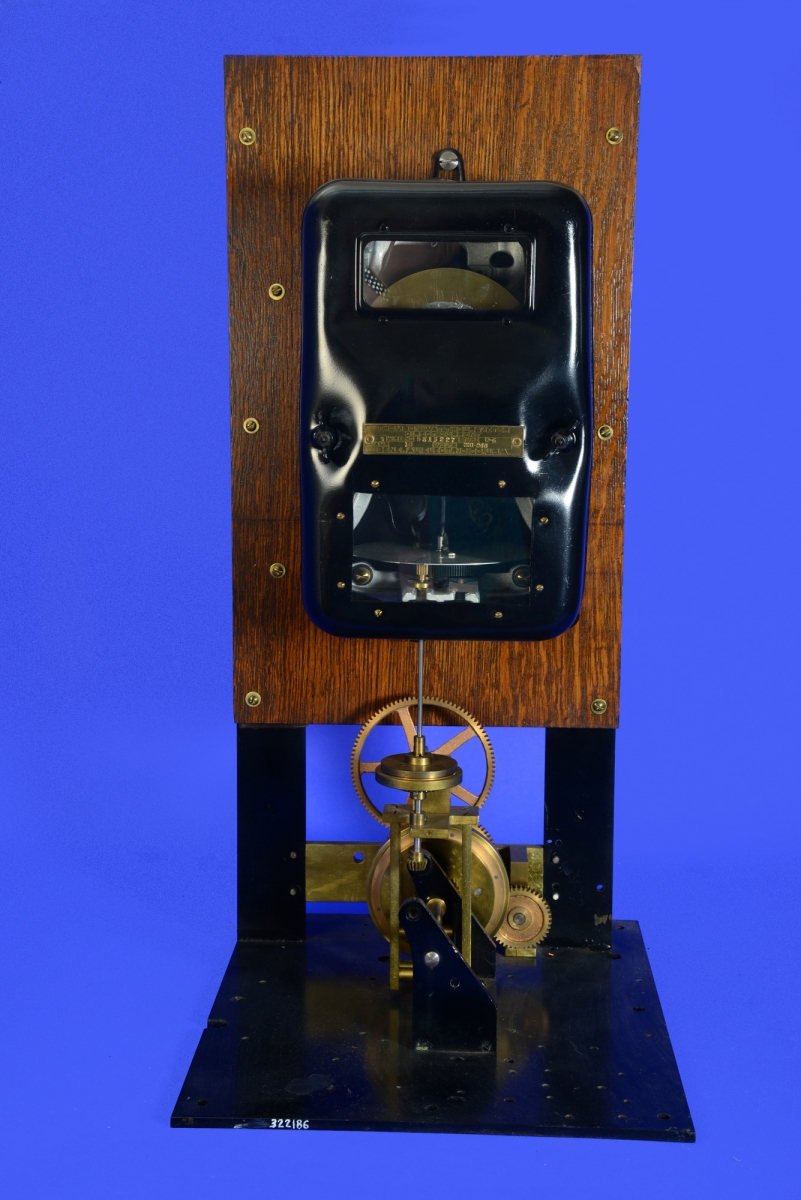
Portion of the Bush Product Integraph, ca 1925, Smithsonian Institution negative number NMAH-AHB2016q152378
By the early 20th century, engineers, physicists, and mathematicians were familiar with instruments that could integrate functions mechanically. Integraphs, which plotted the integral of a function, had sold for decades. The electrical engineer Vannevar Bush (1890–1974) and two of his MIT colleagues devised this instrument, designed to find the integral of the product of two functions. Both the functions and the integral of the product were drawn on sheets of paper (these sheets, and the table that held them, were not collected). From this start in the mid-1920s, Bush would go on to build room-sized differential analyzers—analog computing devices with even greater capabilities. He then became vice-president of MIT and would head the Office of Scientific Research and Development during World War II.
For a description of simpler instruments used to find the area bounded by plane curves, see https://americanhistory.si.edu/collections/object-groups/planimeters. For an account of integrators and differential analyzers, see https://americanhistory.si.edu/collections/object-groups/mechanical-integrators.
Mathematical Treasure: RCA Flowcharting Template
When I took my first programing classes in high school and then college, I had to create by hand flowcharts of the logic. Certain shapes denote certain actions. For example, a horizontal diamond represents a decision point, while a horizontal rectangle represents a process. Flowcharts could get pretty complicated for even a program of moderate length. Today flowcharts, for programing or organizational needs, can be made using any one of numerous computer applications. (One must ask if the programmers who designed these virtual flowchart creators used a flowchart in their design process, and if so, paper or virtual? Interesting origin questions.) Professional programmers back in the day used clear plastic templates to help create flowcharts that looked professional. Developed in the 1950s during the early days of programing in industry, these templates are the “big boy” versions of the shape or animal drawing templates with which many kids play. They were often made and distributed by computer manufacturers to encourage interest in and sales of their machines.
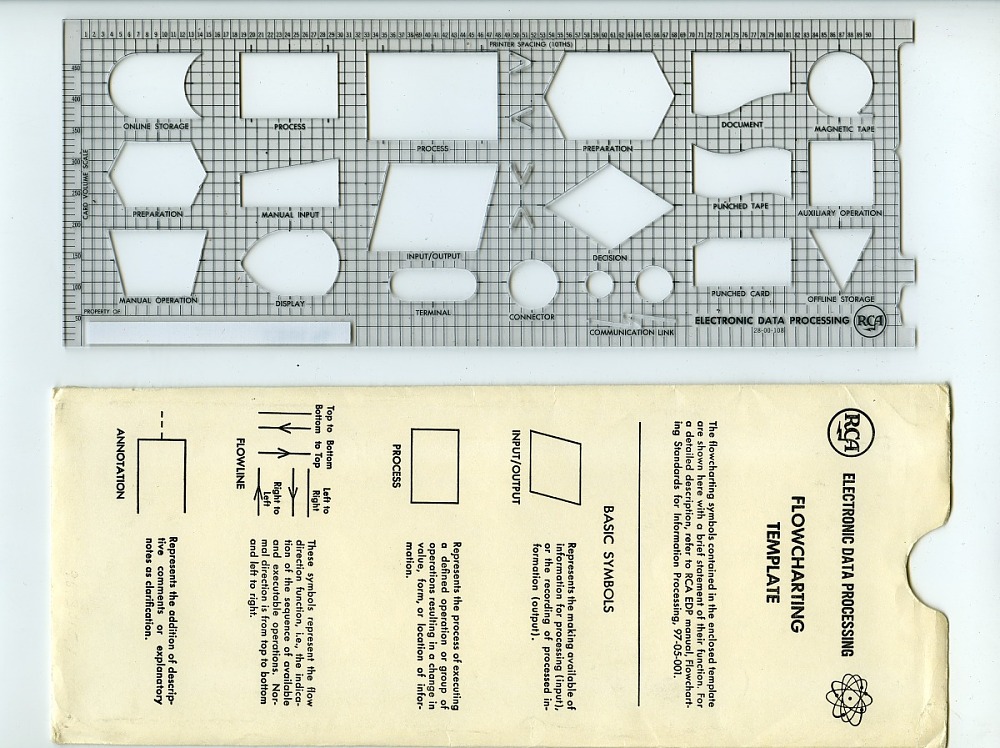
RCA Electronic Processing Flowcharting Template, ca 1960,
Smithsonian Institution negative number AHB2012q05382.
Along with the outlines of all the commonly-used shapes needed to create a flowchart, this template contains two scales. Across the top is a scale for printer spacing running from 0 to 90, while down the left side is a scale for card volumes from 0 to 450, which allows one to estimate the number of punch cards in a stack and thus approximate the run time.
The complete collection of 24 Flowcharting Templates from the Smithsonian Institution’s National Museum of American History can be viewed at https://americanhistory.si.edu/collections/object-groups/flowcharting-templates.
Mathematical Treasure: Raymond Clare Archibald's Slide Rule
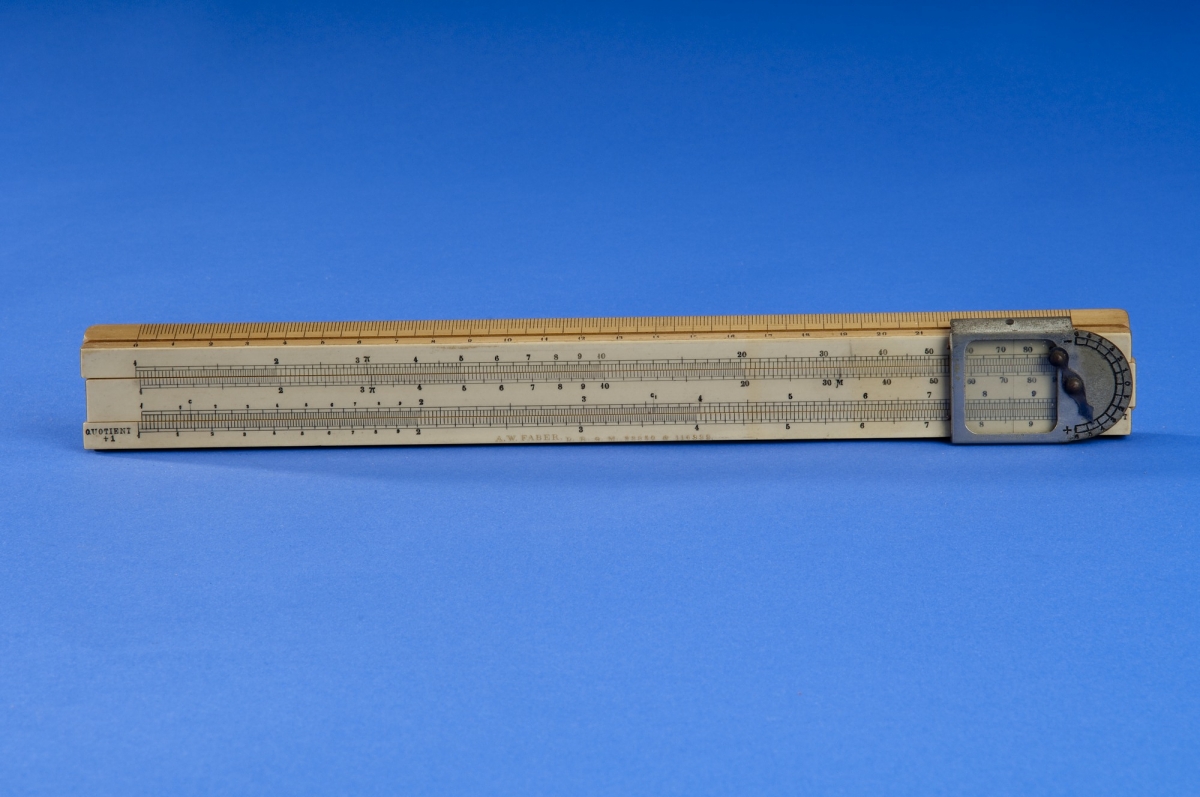
A. W. Faber Mannheim Simplex Slide Rule Owned By R. C. Archibald, 1900–1908, Smithsonian Institution negative number DOR2010-0283.
Raymond Clare Archibald (1875-1955) was born in Nova Scotia and attended Mount Allison College in New Brunswick. He then earned bachelor's and master's degrees from Harvard University. In 1898, he traveled to Germany, which was the destination for many North Americans of the time seeking higher education. He spent one academic year at the University of Berlin and one academic year at the University of Strasbourg, receiving his doctorate from the latter institution in 1900.
This slide rule was manufactured in Germany by the firm of A. W. Faber. It was made after June 1899, which is when a patent mentioned on the instrument was issued. Archibald thus may have purchased the rule while he was in Germany. However, the type of cursor (or runner) on the rule, with the dial for registering digits, was not added until 1905. Even if Archibald imported the rule after he returned to North America, he held on to it for the rest of his career.
That career was as one of the most prominent mathematicians of the first half of the 20th century. After teaching at Mount Allison for seven years, he served on the faculty of Brown University from 1908 to 1943. He built up the institution's library, was a charter member of the Mathematical Association of America and its president in 1922, served as councilor (1918–1941) and librarian (1922–1941) of the American Mathematical Society, was twice elected vice president of the American Association for the Advancement of Science, and participated in the National Research Council. He contributed to the history of mathematics and the computation of mathematical tables.
This object and other slide rules from the Smithsonian's National Museum of American History are now shown and described at the website http://americanhistory.si.edu/collections/object-groups/slide-rules.
Mathematical Treasure: Rhombic Dodecahedron Dissected into Two Cubes
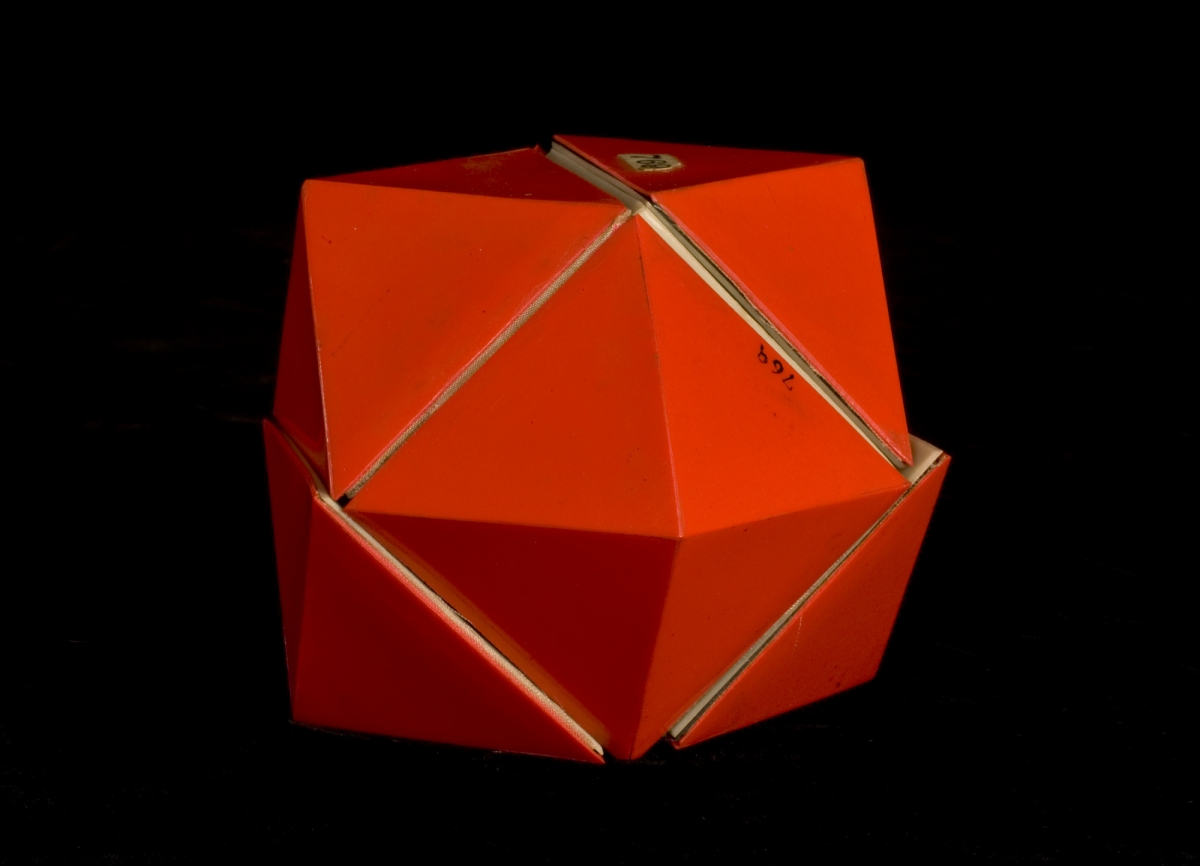
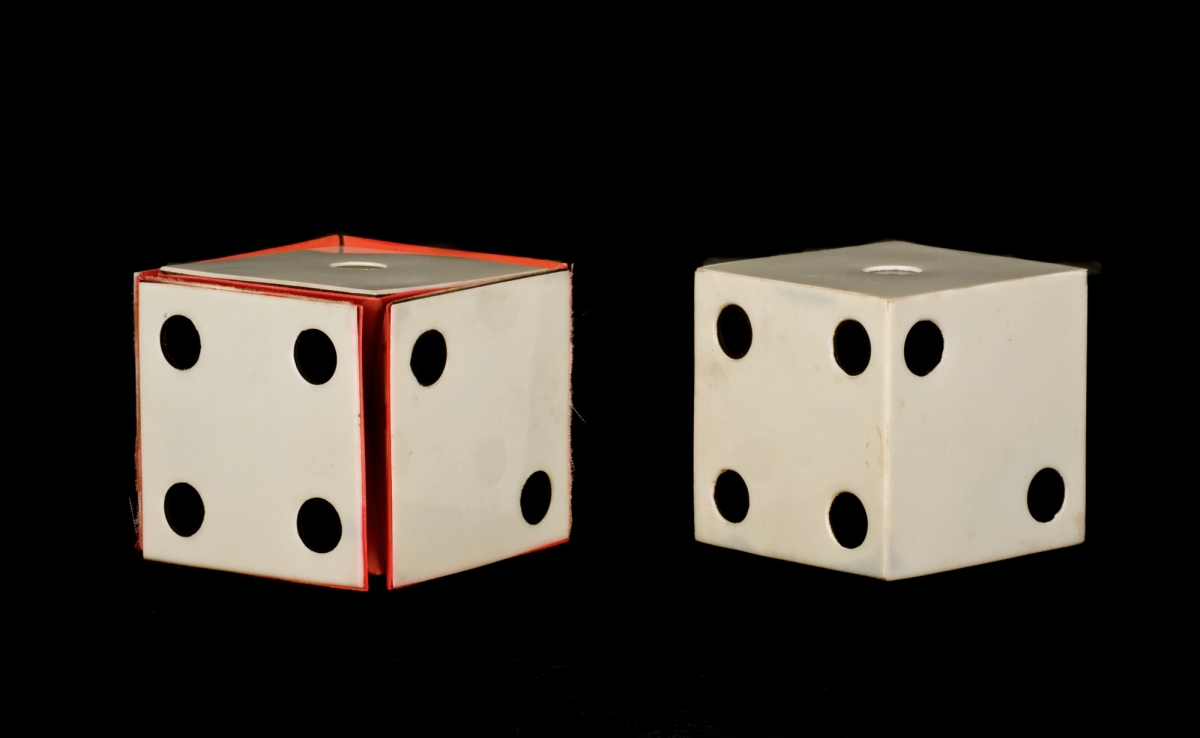
A model of a dissected rhombic dodecahedron by A. Harry Wheeler, rearranged as two cubes. Smithsonian Institution negative numbers JN2012-0969 and JN2012-0966
During the 1930s, high school mathematics teacher A. Harry Wheeler (1873–1950) of Worcester, Massachusetts, built several models of polyhedra that could be divided and rearranged to form other polyhedra. The pieces of this colorful plastic model show either an orange-colored rhombic dodecahedron or, if rearranged, two cubes with faces like those of dice. Wheeler sometimes called this construction “Pair-a-Dice.” When the objects first came into the museum, the two parts had been separated and were subsequently assigned separate museum catalog numbers.
Images of a series of dissected polyhedra by Wheeler and at least one of his students are shown at: https://americanhistory.si.edu/collections/object-groups/geometric-models-dissected-polyhedra.
Mathematical Treasure: Richard P. Baker’s Model of a Thermodynamic Surface
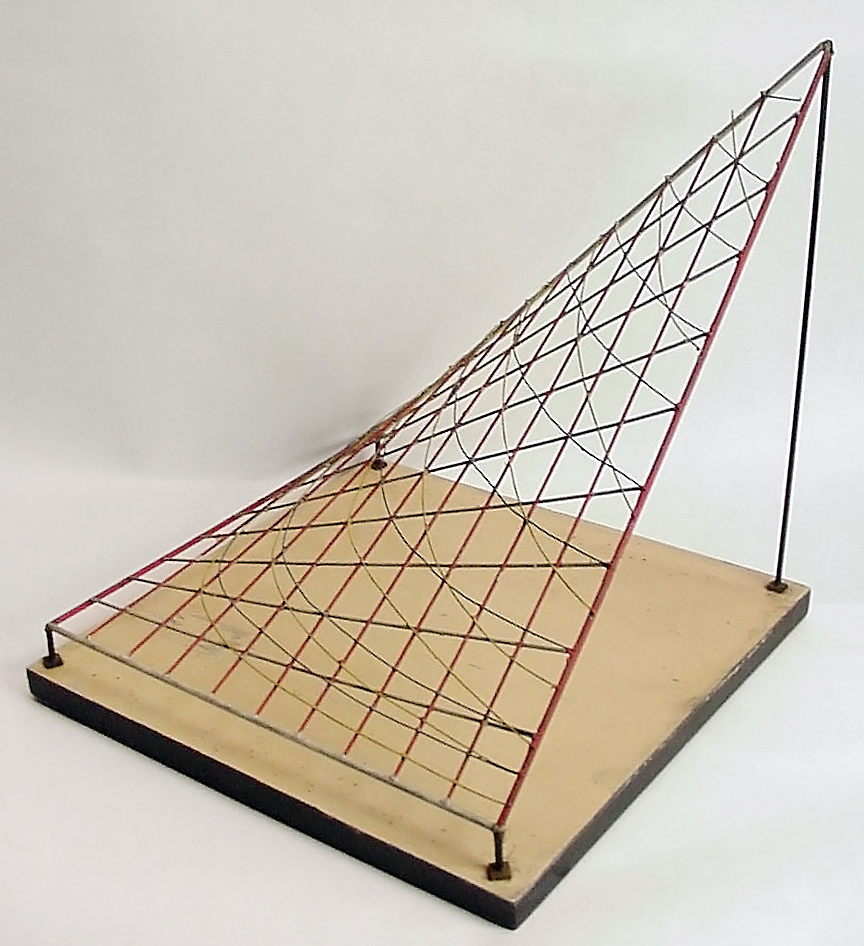
Model of thermodynamic surface, representing the behavior of a perfect gas, ca 1906–1935, Smithsonian Institution negative number NMAH2003-12889
Around 1900, mathematicians across the world acquired physical models, both to illustrate concepts they taught and to demonstrate familiarity with new ideas. They frequently purchased models from Europe, especially Germany. A few Americans also designed and made models. One of them was English-born Richard P. Baker (1866–1937), who began making models while he was a graduate student at the University of Chicago, publishing his first list of 100 models in 1905. These objects largely followed contemporary textbooks. By 1931. Baker was a professor of mathematics at the University of Iowa, and he had designed over 500 models, many on more abstract topics. Baker’s designs also included surfaces associated with areas of physics such as thermodynamics. This model shows the temperature, pressure, and volume of a perfect gas, as represented on surfaces like those envisioned by the distinguished American mathematical physicist J. Willard Gibbs. For a description of the Baker models that survive at the National Museum of American History, see https://americanhistory.si.edu/collections/object-groups/geometric-models-baker.
Mathematical Treasure: Rubik's Cube Museum Promotional Pen
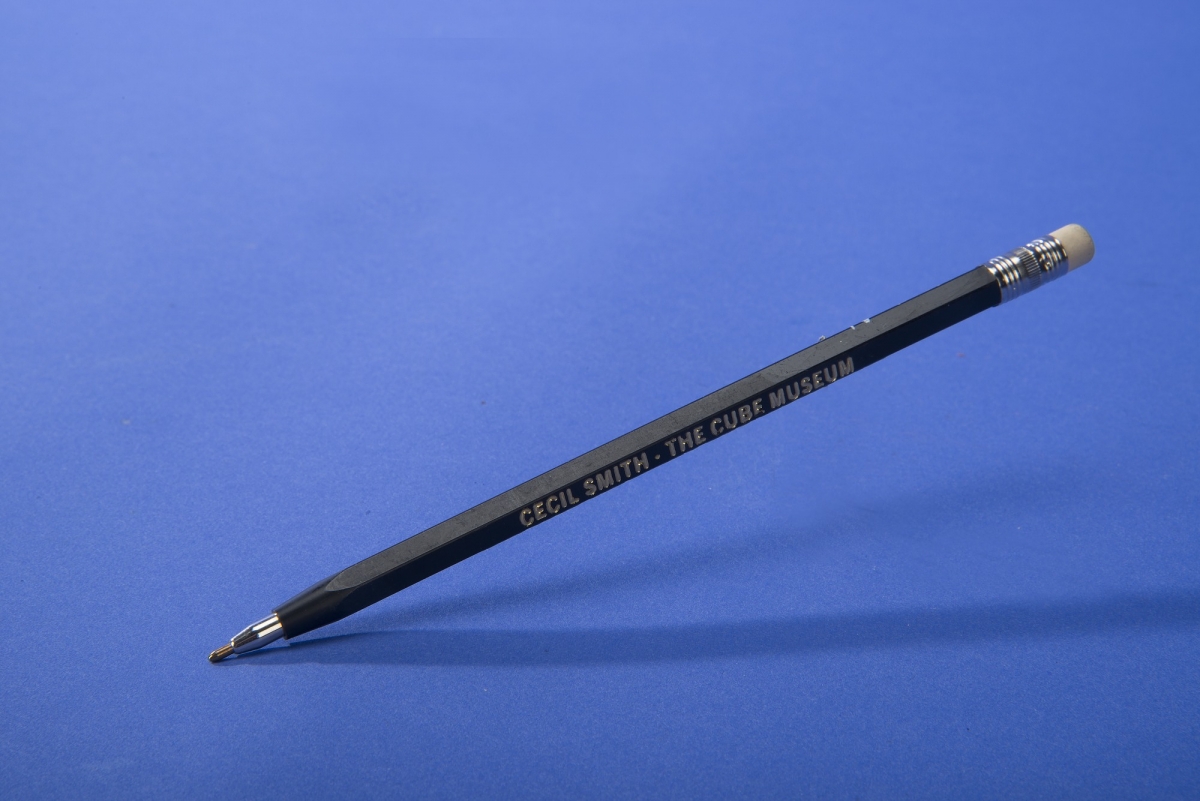
Pen Advertising Cube Museum, 1988–1991, Smithsonian Institution negative number DOR2013-17382.
Until the advent of computer-aided drafting, mathematicians and those doing mathematical tasks, such as mechanical or architectural drawing, needed writing implements to carry out their work. Pens and pencils may also be used in mathematics education. Others are important to us because they were owned by famous figures, such as Herman Hollerith. This one, however, tells us about mathematical fads and the people who promote them.
In 1980, the Ideal Toy Corporation began to distribute Rubik's Cube, a plastic six-sided and six-colored puzzle invented in 1974 by Hungarian sculptor Ernö Rubik. The item quickly became wildly popular around the world, prompting solution books, competitions, related merchandise, and even a television show. From 1988 to 1991, Cecil Smith (b. 1929), a visually impaired artist from Delta, Colorado, operated the Cube Museum to display his collection of Cubes and the patterns he formed with them. He advertised his facility on ballpoint pens.
This object and other pens and pencils from the Smithsonian's National Museum of American History are now shown and described at the website http://americanhistory.si.edu/collections/object-groups/pens-and-pencils.
Mathematical Treasure: Sector from Jesse Ramsden's Workshop
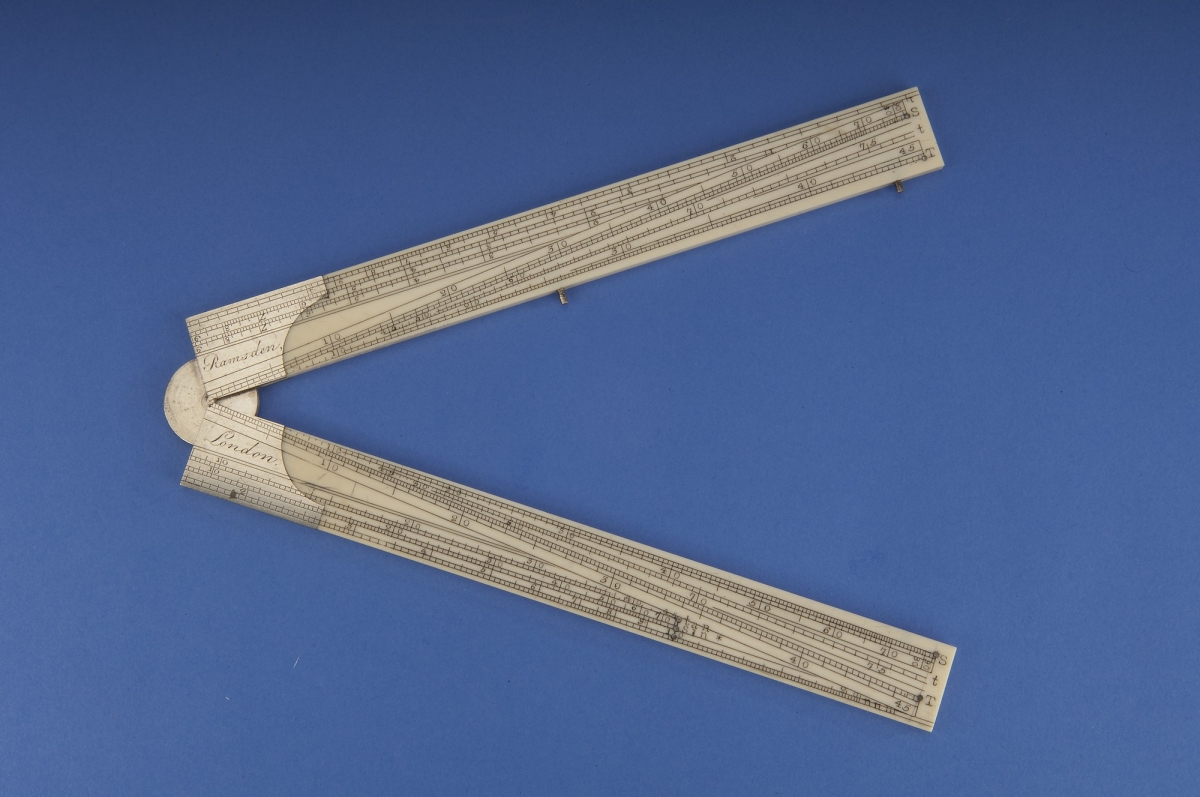
Jesse Ramsden, Sector in the English Style, 1765–1800, Smithsonian Institution negative number DOR2012-2586.
Jesse Ramsden (1735–1800) was one of the most famous British makers of mathematical instruments. Among his achievements was the invention of a circular dividing engine, which made it possible to mechanically inscribe scales of angles on surveying, astronomical, and drawing instruments.
His workshop also produced this sector, a calculating instrument used in Europe and North America from the 17th to the 19th centuries. Users employed a pair of dividers to measure distances between points on the scales on a sector and make calculations using the principle of similar triangles. They could figure out proportions useful for designing military fortifications and solving other problems involving regular polygons, positioning and loading artillery, working with different types of metals, determining ratios between volumes or between areas, constructing angles, and calculating square and cube roots. English sectors were unique in that they often had scales for making sundials, for trigonometry, for navigation, and, as is visible on this instrument, for computing with logarithms. The latter scales made English sectors a forerunner of slide rules.
This object and other sectors from the Smithsonian's National Museum of American History are now shown and described at the website http://americanhistory.si.edu/collections/object-groups/sectors.
Mathematical Treasure: Statistical Tabulator of Benjamin Wood
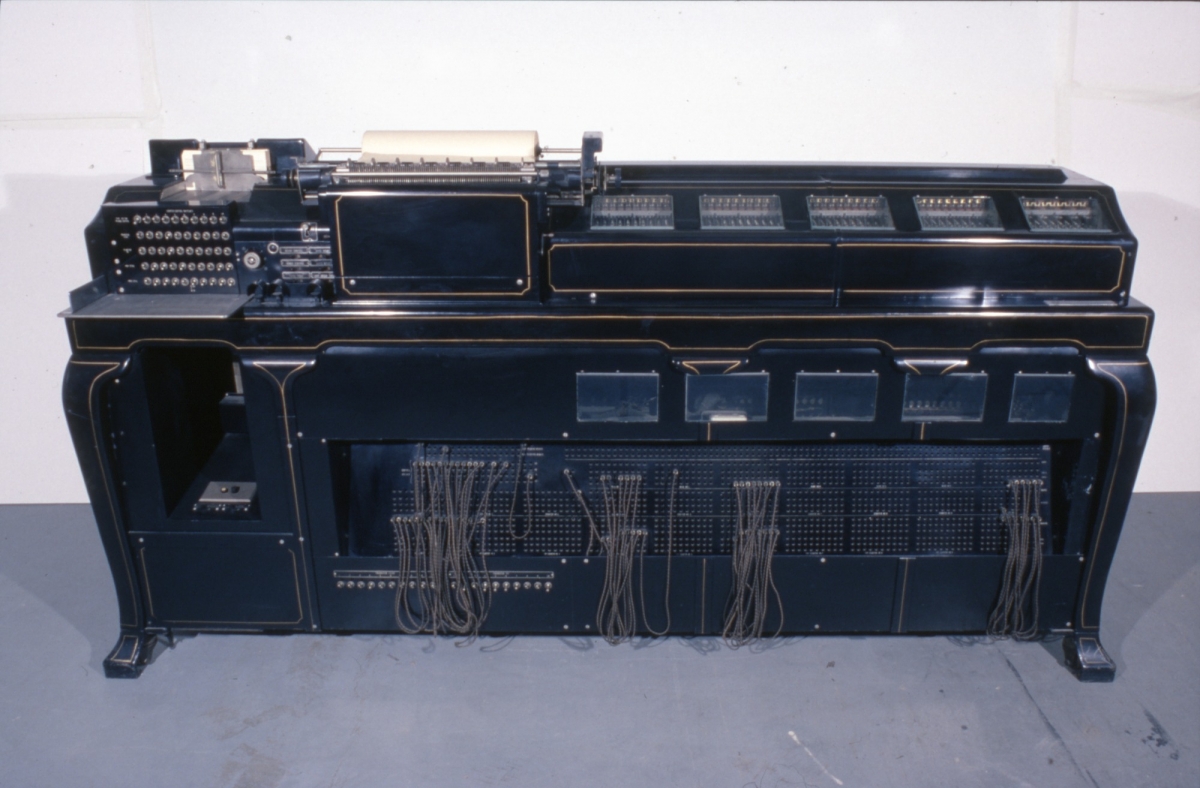
IBM Statistical Tabulator, 1929, Smithsonian Institution negative number 92-1753.
From the 1890s, Americans built machines called tabulating machines to compile statistics. First used by the U.S. Census Bureau, they were adopted by businesses carrying out large numbers of routine calculations and, more slowly, by scientists and mathematicians.
The IBM statistical tabulator is a specially built tabulator, designed to correlate test results and produce scientific tables. It read data from punched cards and from entries in any of ten 10-digit counters. It also multiplied numbers together, summed the products, and printed these out. Wiring of a plugboard determined the precise sequence of operations performed.
In the late 1920s, Benjamin Wood, a young psychologist at Columbia University, wrote to several manufacturers requesting assistance in the design of equipment for scoring psychological tests. James D. Watson, president of IBM, offered his assistance in the form of standard IBM machines and the help of IBM engineers in designing special models like this one. The Columbia machine, as it was sometimes called, was used both in test grading and in the production of astronomical tables, long a concern of mathematical physicists. Although it was soon superseded by other IBM equipment, its success inspired Wood to consider other inventions, particularly machines that scored tests directly from forms marked in pencil, eliminating the need for punch cards. Such machines and score sheets would be used for decades. More generally, scholarly use of tabulating equipment spread throughout the United States.
This object, and other tabulating machines in the collections of the National Museum of American History, are shown and described at the website http://americanhistory.si.edu/collections/object-groups/tabulating-equipment.
Mathematical Treasure: Thomas Hill’s Patent Model for a Key-Driven Adding Machine
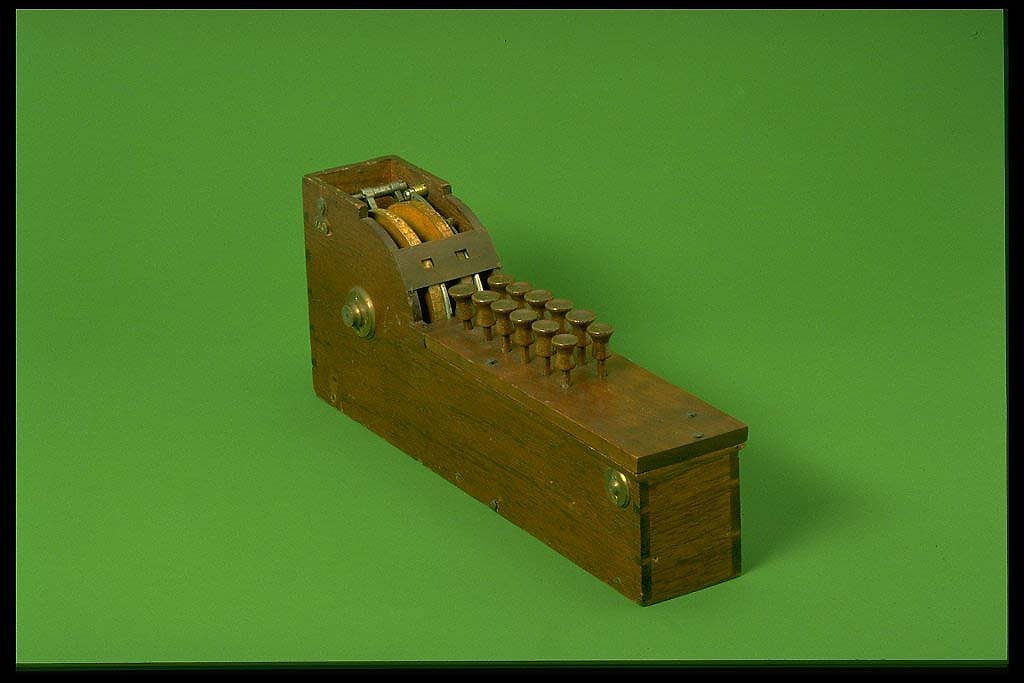
Thomas Hill’s patent model for an adding machine, 1857, Smithsonian Institution negative number 87-5869.
In the nineteenth century, adding and calculating machines became practical commercial products. Several inventors proposed such machines, including Thomas Hill. Hill, a student of Benjamin Peirce during his undergraduate years at Harvard, became a Unitarian minister and a mathematics textbook author. He served as president of Harvard University from 1862 to 1868.
Hill took an active interest in invention and improvement. He called his machine an “arithmometer,” after the invention of the Frenchman Charles Xavier Thomas. Going beyond Thomas, he proposed that numbers should be entered by pressing keys. Although Hill’s patent did not lead directly to any commercial product, keys became a standard part of adding and calculating machines and survived into the age of the electronic calculator.
This object and other adding machines from the Smithsonian Institution’s National Museum of American History are shown at the website http://americanhistory.si.edu/collections/object-groups/adding-machines.
Mathematical Treasure: Trigonometer for Use with Artillery
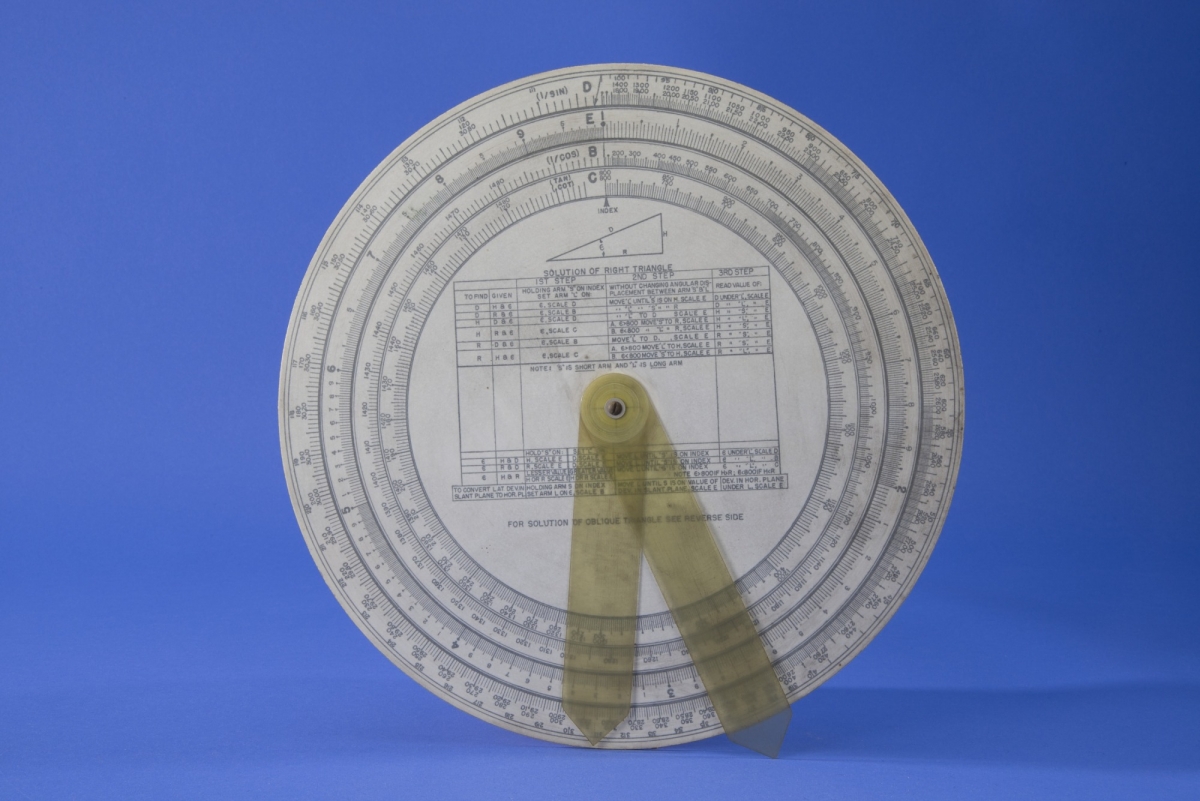
Barnaby C. Keeney’s trigonometer, ca 1942, Smithsonian Institution negative number DOR2013-17462
Interconnections between the angles and the lengths of the sides of triangles have long interested not only mathematicians and astronomers, but also those surveying land and aiming guns. Trigonometric scales were incorporated into instruments such as quadrants, sectors, and slide rules. During World War II, special-purpose instruments like this one were provided to those training to be antiaircraft officers in the U.S. Army. Barnaby Conrad Keeney (1914–1980), who used this instrument during his training, would go on to complete a doctorate in history and then serve as president of Brown University. He apparently gave his trigonometer to the Mathematics Department at Brown, which in time presented it to the Smithsonian.
Several instruments utilizing plane trigonometry, including this one, are shown at: https://americanhistory.si.edu/collections/object-groups/trigonometry-in-the-plane.
Mathematical Treasure: Troncet Arithmographe Owned by Daniel Draper
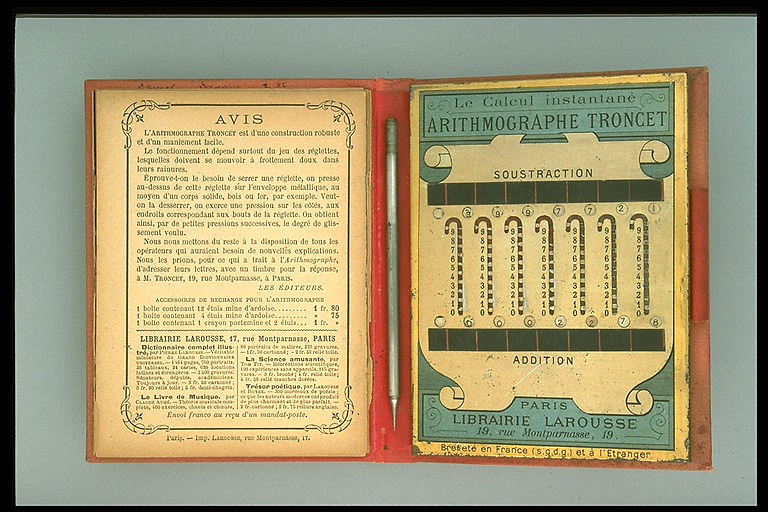
Troncet Arithmographe, an Adder or Aid to Arithemetic, 1895, Smithsonian negative number 94-3981.
From the mid-19th century, Americans have used simple instruments to assist them in doing arithmetic. Some of these did not actually add and subtract, but made it easier for users to do so. Louis-J. Troncet patented this instrument in his native France in 1889, and it was published there by Larousse. The Troncet arithmographe, like an instrument issued by the Russian Heinrich Kummer in the 1840s, used flat metal bands with notched edges to represent digits. These bands were moved with the stylus to enter numbers. The New York meteorologist Daniel Draper purchased this example for $2.50. It came in a small notebook with a set of multiplication tables.
By the 1920s, as adding and calculating machines became common, a growing number of makers and dealers also offered these portable, less expensive instruments. Troncet’s design was widely adopted.
Following World War II, manufacture of adders shifted almost entirely to Germany and Japan. A few carried out calculations in base 60 and were marketed to computer scientists. During the 1970s, newly introduced inexpensive electronic calculators replaced the adder.
For information about other adders, see the National Museum of American History website http://americanhistory.si.edu/collections/object-groups/adders.
Mathematical Treasure: Wang Loci-2 Programmable Calculator
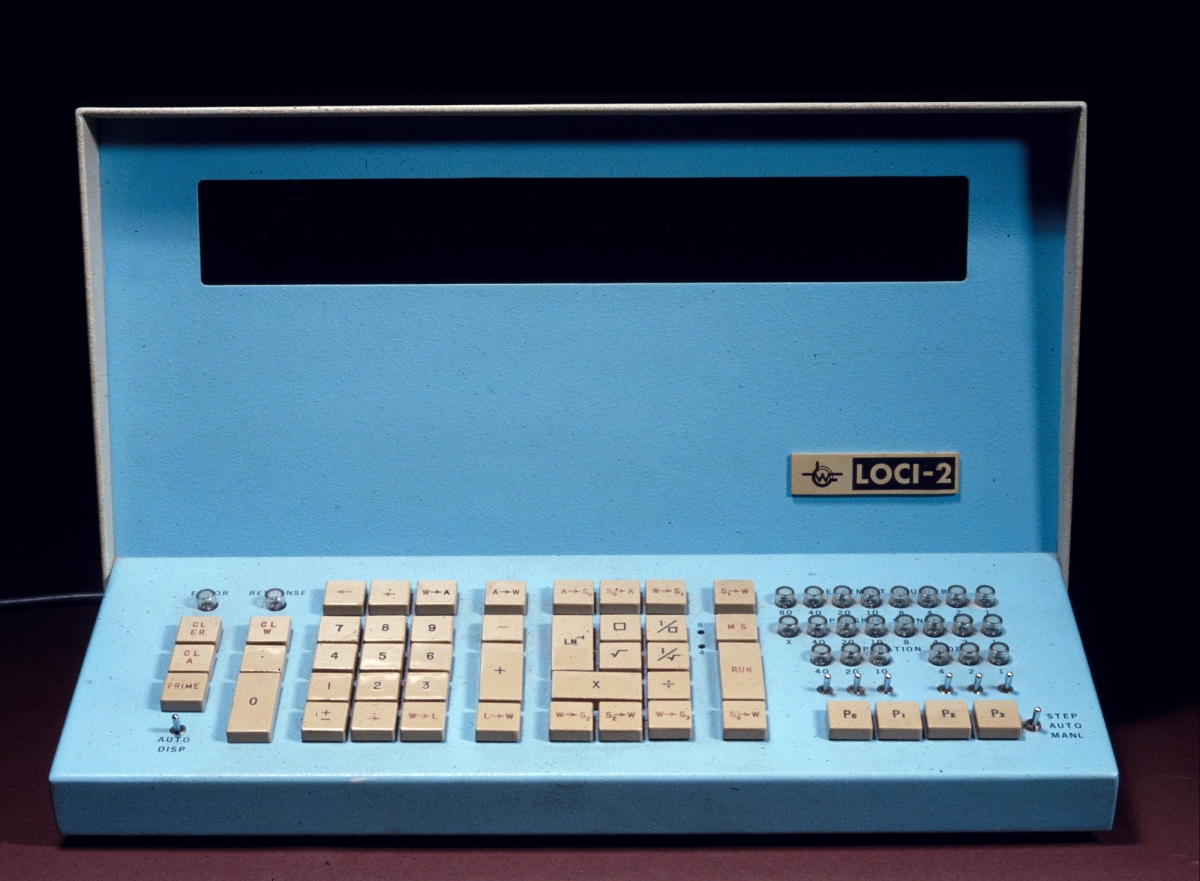
Wang LOCI-2 Desktop Programmable Calculator, 1965 or later, Smithsonian Institution negative number 80-14510.
By the early 1960s, the invention of the transistor made it possible to build electronic calculators that would fit on a desktop. A few of these—such as this Wang LOCI-2—could be programmed. An Wang, the inventor of the calculator, was a native of Shanghai, immigrated to the United States after World War II, studied computer science at Harvard University, and worked at the Harvard Computation Laboratory. He started his own business in 1951, producing magnetic core memories and other electronic equipment on order. The LOCI or “logarithmic calculating instrument” was the first product marketed by Wang Laboratories. Two versions of the machine were announced: the LOCI-1, which was not programmable, and the LOCI-2, which was. In the 1970s, handheld electronic calculators largely displaced desktop calculators. Wang and his colleagues turned their attention to the design of minicomputers.
For information about other desktop electronic calculators in the collections of the Smithsonian’s National Museum of American History, see http://americanhistory.si.edu/collections/object-groups/desk-calc.